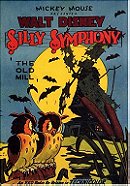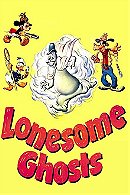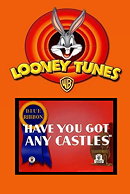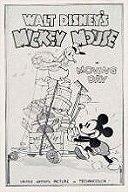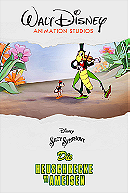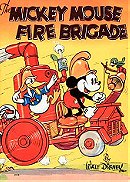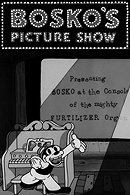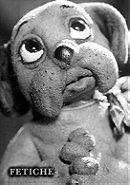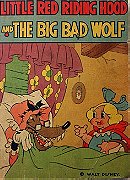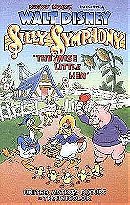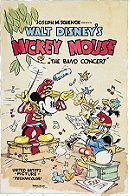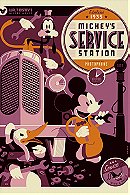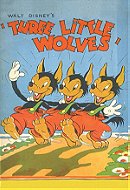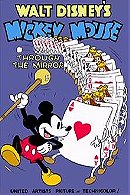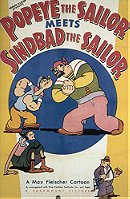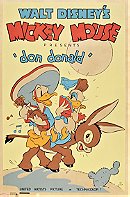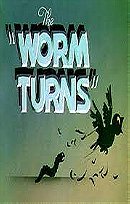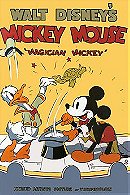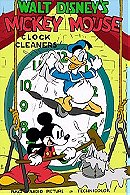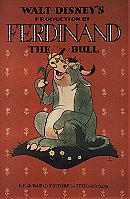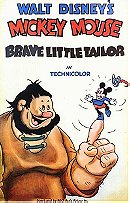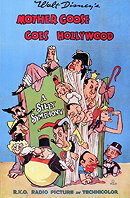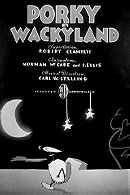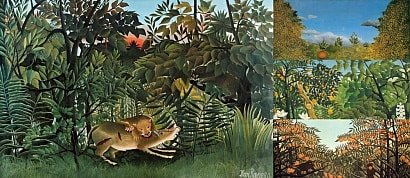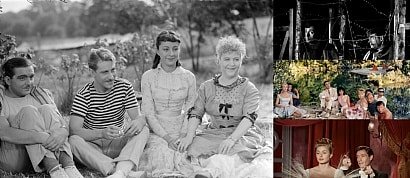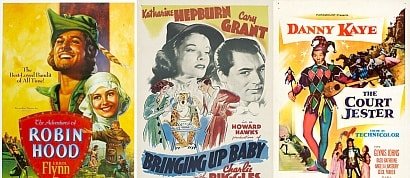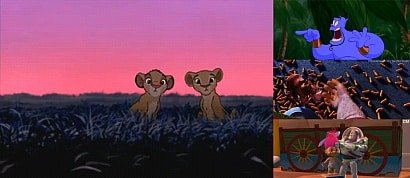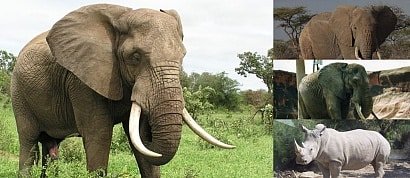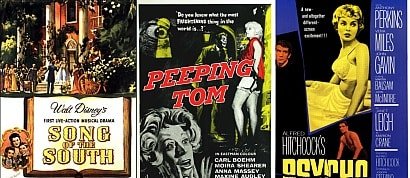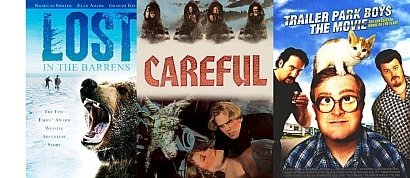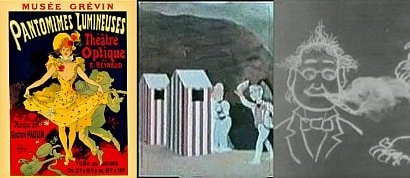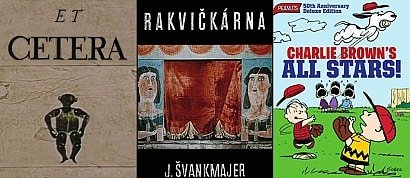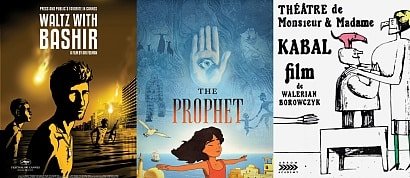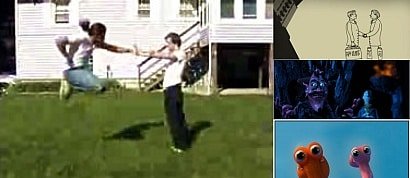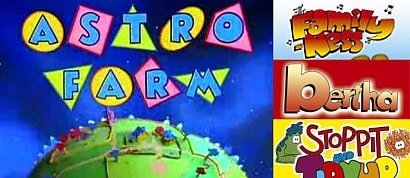1001 Animated Shorts You Must See - Part 2
Sort by:
Showing 50 items
Decade:
Rating:
List Type:
DIR: Dave Fleischer
SUMMARY: A retelling of the Cinderella story with Betty Boop in the title role.
WHY IT'S HERE: The Fleischer brothers started their Color Classics series with this lavish Betty Boop cartoon, the only original Boop short in colour. At the time of 'Poor Cinderella's production, Disney still held an exclusive contract with Three Strip Technicolor so the Fleischer's had to use 2 strip Cinecolor. Though less striking visually, the more faded colours of this process somehow fit the storybook atmosphere and give 'Poor Cinderella' a more authentic feel. The Fleischers also made Betty a redhead to take advantage of the extra colour, although that seems less convincing. Unlike the more inventive flights of fancy in the Fleischer's 'Snow White', 'Poor Cinderella' is an extremely faithful if truncated telling of the fairy tale. There's an obvious attempt to make something classy going on here and it succeeds to an extent, although the Fleischers would soon surpass 'Poor Cinderella' with their 3 strip, double length, colour Popeye shorts that remain masterpieces of the medium.
SUMMARY: A retelling of the Cinderella story with Betty Boop in the title role.
WHY IT'S HERE: The Fleischer brothers started their Color Classics series with this lavish Betty Boop cartoon, the only original Boop short in colour. At the time of 'Poor Cinderella's production, Disney still held an exclusive contract with Three Strip Technicolor so the Fleischer's had to use 2 strip Cinecolor. Though less striking visually, the more faded colours of this process somehow fit the storybook atmosphere and give 'Poor Cinderella' a more authentic feel. The Fleischers also made Betty a redhead to take advantage of the extra colour, although that seems less convincing. Unlike the more inventive flights of fancy in the Fleischer's 'Snow White', 'Poor Cinderella' is an extremely faithful if truncated telling of the fairy tale. There's an obvious attempt to make something classy going on here and it succeeds to an extent, although the Fleischers would soon surpass 'Poor Cinderella' with their 3 strip, double length, colour Popeye shorts that remain masterpieces of the medium.
DIR: Frank Tashlin
SUMMARY: The villainous Lawyer Goodwill, under the influence of a Jekyll and Hyde potion, attempts to do Porky and his family out of their inheritance by doing them in.
WHY IT'S HERE: Frank Tashlin's 'The Case of the Stuttering Pig' is as strong a testament as any to the fact that Tashlin was an underrated director. A beautiful piece of storytelling with plenty of room for gags and a few scares, 'The Case of the Stuttering Pig' is a sumptuous horror film. Setting the scene brilliantly with a creepy, knowingly clichéd thunderstorm as a backdrop for the reading of the will, Tashlin proceeds to introduce one of the great cartoon villains. Lawyer Goodwill begins as a too-good-to-be-true humanitarian but, even before the reveal, it's clear that something is quite wrong with this apparently benevolent soul. There follows a cracking sequence in which Lawyer Goodwill transforms himself into a hideous villain, lunging towards the camera as he addresses the audience directly. This scene is startlingly creepy on a TV screen so one can only imagine the impact it must have had on a cinema screen. The initial transformation features an hilarious gag in which the potion doesn't take and Lawyer Goodwill stands staring blankly out into the audience in anticipation of an effect that doesn't arrive. The subsequent pursuit of Porky by the monstrous Goodwill is extremely effective and culminates in a predictable but pleasing gag. You can imagine that every guy in the third row during a showing of 'The Case of the Stuttering Pig' was probably squirming uncomfortably throughout and cheering triumphantly at the climax. A masterpiece.
SUMMARY: The villainous Lawyer Goodwill, under the influence of a Jekyll and Hyde potion, attempts to do Porky and his family out of their inheritance by doing them in.
WHY IT'S HERE: Frank Tashlin's 'The Case of the Stuttering Pig' is as strong a testament as any to the fact that Tashlin was an underrated director. A beautiful piece of storytelling with plenty of room for gags and a few scares, 'The Case of the Stuttering Pig' is a sumptuous horror film. Setting the scene brilliantly with a creepy, knowingly clichéd thunderstorm as a backdrop for the reading of the will, Tashlin proceeds to introduce one of the great cartoon villains. Lawyer Goodwill begins as a too-good-to-be-true humanitarian but, even before the reveal, it's clear that something is quite wrong with this apparently benevolent soul. There follows a cracking sequence in which Lawyer Goodwill transforms himself into a hideous villain, lunging towards the camera as he addresses the audience directly. This scene is startlingly creepy on a TV screen so one can only imagine the impact it must have had on a cinema screen. The initial transformation features an hilarious gag in which the potion doesn't take and Lawyer Goodwill stands staring blankly out into the audience in anticipation of an effect that doesn't arrive. The subsequent pursuit of Porky by the monstrous Goodwill is extremely effective and culminates in a predictable but pleasing gag. You can imagine that every guy in the third row during a showing of 'The Case of the Stuttering Pig' was probably squirming uncomfortably throughout and cheering triumphantly at the climax. A masterpiece.
DIR: Wilfred Jackson
SUMMARY: A community of animals living in and around an old mill must weather a severe thunderstorm that almost destroys their home.
WHY IT'S HERE: One of the very last Silly Symphonies, Disney's 'The Old Mill' is also one of the most beautiful pieces of animation of all time. By this stage, with their first full length feature in the pipeline, the studio had begun primarily using the Silly Symphonies as a testing ground for animation techniques. Far from harming the series, this actually resulted in the cartoons becoming even more breathtaking. The lack of narrative here is refreshing and all but unnoticeable amidst the groundbreaking examples of realistic animal behaviour and weather effects. This also marked Disney's first use of the multiplane camera. All these elements were important in making 'Snow White and the Seven Dwarfs' the classic it is but in developing the techniques Disney created another, shorter classic first. 'The Old Mill' still looks astonishing today and is clearly a crucial stepping stone in Disney's growing sophistication.
SUMMARY: A community of animals living in and around an old mill must weather a severe thunderstorm that almost destroys their home.
WHY IT'S HERE: One of the very last Silly Symphonies, Disney's 'The Old Mill' is also one of the most beautiful pieces of animation of all time. By this stage, with their first full length feature in the pipeline, the studio had begun primarily using the Silly Symphonies as a testing ground for animation techniques. Far from harming the series, this actually resulted in the cartoons becoming even more breathtaking. The lack of narrative here is refreshing and all but unnoticeable amidst the groundbreaking examples of realistic animal behaviour and weather effects. This also marked Disney's first use of the multiplane camera. All these elements were important in making 'Snow White and the Seven Dwarfs' the classic it is but in developing the techniques Disney created another, shorter classic first. 'The Old Mill' still looks astonishing today and is clearly a crucial stepping stone in Disney's growing sophistication.
DIR: Frank Tashlin
SUMMARY: Porky attempts to woo Petunia Pig but finds that the course of true love never runs smoothly.
WHY IT'S HERE:Frank Tashlin's 'Porky's Romance' opens with a special pre-credits announcement: "Ladies and Gentlemen, introducing Leon Schlesinger's new Looney Tunes star, Petunia Pig". Petunia introduces herself in a routine not dissimilar to the nerve-wracked recital that shot Porky Pig to fame in 'I Haven't Got a Hat'. Just how seriously the studio took Petunia's potential is unclear but, if she was intended to be a new cartoon superstar they didn't give her much of an opportunity to endear herself to the audience. In 'Porky's Romance', Petunia is cruel, selfish, idle and greedy and, while this may not have been beneficial for the character's longevity, it is extremely beneficial for the cartoon. 'Porky's Romance' is a great and handsome piece of work in which Porky goes through an emotional roller coaster which even includes a suicide attempt when his proposal to Petunia is turned down. While Porky spends most of the cartoon being dumped on by everyone, he finally gets the last laugh in one of the most satisfying final moments in any cartoon. 'Porky's Romance' is a film that aims to make audiences laugh, cry and wince in equal measure as we empathise with the nightmare of Porky's heartbreak and then the even more horrific glimpse at the possibilities of married life (a slightly sexist representation by today's standard but this was the 30s!). Tashlin's talents as storyteller and crafter of characters is much in evidence but, despite turning up in a few more cartoons, Petunia never got to be that new cartoon star. That title was snatched from her just two cartoons after 'Porky's Romance' when Tex Avery's 'Porky's Duck Hunt' introduced a certain little black duck with a penchant for scene-stealing.
SUMMARY: Porky attempts to woo Petunia Pig but finds that the course of true love never runs smoothly.
WHY IT'S HERE:Frank Tashlin's 'Porky's Romance' opens with a special pre-credits announcement: "Ladies and Gentlemen, introducing Leon Schlesinger's new Looney Tunes star, Petunia Pig". Petunia introduces herself in a routine not dissimilar to the nerve-wracked recital that shot Porky Pig to fame in 'I Haven't Got a Hat'. Just how seriously the studio took Petunia's potential is unclear but, if she was intended to be a new cartoon superstar they didn't give her much of an opportunity to endear herself to the audience. In 'Porky's Romance', Petunia is cruel, selfish, idle and greedy and, while this may not have been beneficial for the character's longevity, it is extremely beneficial for the cartoon. 'Porky's Romance' is a great and handsome piece of work in which Porky goes through an emotional roller coaster which even includes a suicide attempt when his proposal to Petunia is turned down. While Porky spends most of the cartoon being dumped on by everyone, he finally gets the last laugh in one of the most satisfying final moments in any cartoon. 'Porky's Romance' is a film that aims to make audiences laugh, cry and wince in equal measure as we empathise with the nightmare of Porky's heartbreak and then the even more horrific glimpse at the possibilities of married life (a slightly sexist representation by today's standard but this was the 30s!). Tashlin's talents as storyteller and crafter of characters is much in evidence but, despite turning up in a few more cartoons, Petunia never got to be that new cartoon star. That title was snatched from her just two cartoons after 'Porky's Romance' when Tex Avery's 'Porky's Duck Hunt' introduced a certain little black duck with a penchant for scene-stealing.
DIR: Frank Tashlin
SUMMARY: Porky Pig and a gang of forest animals conspire to teach the evil Jean Baptiste a lesson about the folly of animal cruelty.
WHY IT'S HERE: Many of the great Warner Bros. cartoons seemed to suggest a humane, anti-hunting message. Elmer Fudd, the greatest dupe of them all, was frequently a hunter and in almost every hunting picture, regardless of who played the hunter, the prey came out on top. Frank Tashlin's 'Porky in the North Woods' makes this anti-hunting angle explicit, casting Porky as the owner of a stretch of forest in which animal cruelty of any kind is forbidden. Enter Jean Batiste, a hunter who is determined to ignore this. In a typically brilliant, cinematic approach, Tashlin only shows Batiste is shadow for the first half of the cartoon, making him all the more threatening. When he finally puts in a proper appearance, he brutalises Porky in quite an extreme way, all of which makes his inevitable comeuppance all the more satisfying.
A beautiful, strongly ethical cartoon, 'Porky in the North Woods' occasionally suffers from overly cute characters, chiefly the irritating beavers. I've loved beavers all my life, they've always been one of my favourite animals, yet 'Porky in the North Woods' occasionally makes me want to kill beavers! It's a shame because, when they're not talking in their grating childlike voices, the beaver characters have some fantastic moments such as their war over an apple. Another element which is often cited as a flaw in 'Porky in the North Woods' is Tashlin's very quick cuts between scenes but I actually find this technique exhilarating. Probably used mainly because Tashlin had too many ideas for a mere seven minutes, these cuts increase the already occasionally frantic pace, making 'Porky in the North Woods' a thrillingly hectic cartoon.
SUMMARY: Porky Pig and a gang of forest animals conspire to teach the evil Jean Baptiste a lesson about the folly of animal cruelty.
WHY IT'S HERE: Many of the great Warner Bros. cartoons seemed to suggest a humane, anti-hunting message. Elmer Fudd, the greatest dupe of them all, was frequently a hunter and in almost every hunting picture, regardless of who played the hunter, the prey came out on top. Frank Tashlin's 'Porky in the North Woods' makes this anti-hunting angle explicit, casting Porky as the owner of a stretch of forest in which animal cruelty of any kind is forbidden. Enter Jean Batiste, a hunter who is determined to ignore this. In a typically brilliant, cinematic approach, Tashlin only shows Batiste is shadow for the first half of the cartoon, making him all the more threatening. When he finally puts in a proper appearance, he brutalises Porky in quite an extreme way, all of which makes his inevitable comeuppance all the more satisfying.
A beautiful, strongly ethical cartoon, 'Porky in the North Woods' occasionally suffers from overly cute characters, chiefly the irritating beavers. I've loved beavers all my life, they've always been one of my favourite animals, yet 'Porky in the North Woods' occasionally makes me want to kill beavers! It's a shame because, when they're not talking in their grating childlike voices, the beaver characters have some fantastic moments such as their war over an apple. Another element which is often cited as a flaw in 'Porky in the North Woods' is Tashlin's very quick cuts between scenes but I actually find this technique exhilarating. Probably used mainly because Tashlin had too many ideas for a mere seven minutes, these cuts increase the already occasionally frantic pace, making 'Porky in the North Woods' a thrillingly hectic cartoon.
DIR: Tex Avery
SUMMARY: Porky Pig goes duck hunting where he encounters a certain crazy little black duck for the first time.
WHY IT'S HERE: 'Porky's Duck Hunt' is a particularly important cartoon for me personally in that it marks the debut of my favourite cartoon character of all time. I've never made a secret of the fact that not only do I love Daffy Duck but I genuinely consider him to be one of the greatest screen comedians of all time (supported by his various directors, animators and Mel Blanc's vocal talents, of course). This exceptional star character was hit upon by accident when he made a scene stealing cameo in this enjoyable if fairly standard hunting picture starring Porky Pig. Porky, like Mickey Mouse, often proved a tricky character to right for because of his essentially sweet natured blandness. Therefore, writers and directors often emphasised other characters more. Although he only makes a couple of fleeting appearances, Daffy Duck immediately won over audiences with his crazed antics and left them hungry for more.
Until now the Warner stars (or attempted stars) had been largely bland creations. Bosko, Buddy, Beans; all hard to write for. Even Porky, who was a hit with audiences, surely couldn't have sustained many more years of shouldering the burden of stardom alone. Daffy's arrival was well timed. Audiences had not been presented with a star so anarchic and unpredictable before and their acceptance of Daffy opened up many new possibilities. With the list of Disney star players growing ever larger, Daffy's innovations lead Warner Bros. to counterbalance Disney's good-natured heroes with an ever-growing collection of more severely-flawed oddballs and wiseguys.
SUMMARY: Porky Pig goes duck hunting where he encounters a certain crazy little black duck for the first time.
WHY IT'S HERE: 'Porky's Duck Hunt' is a particularly important cartoon for me personally in that it marks the debut of my favourite cartoon character of all time. I've never made a secret of the fact that not only do I love Daffy Duck but I genuinely consider him to be one of the greatest screen comedians of all time (supported by his various directors, animators and Mel Blanc's vocal talents, of course). This exceptional star character was hit upon by accident when he made a scene stealing cameo in this enjoyable if fairly standard hunting picture starring Porky Pig. Porky, like Mickey Mouse, often proved a tricky character to right for because of his essentially sweet natured blandness. Therefore, writers and directors often emphasised other characters more. Although he only makes a couple of fleeting appearances, Daffy Duck immediately won over audiences with his crazed antics and left them hungry for more.
Until now the Warner stars (or attempted stars) had been largely bland creations. Bosko, Buddy, Beans; all hard to write for. Even Porky, who was a hit with audiences, surely couldn't have sustained many more years of shouldering the burden of stardom alone. Daffy's arrival was well timed. Audiences had not been presented with a star so anarchic and unpredictable before and their acceptance of Daffy opened up many new possibilities. With the list of Disney star players growing ever larger, Daffy's innovations lead Warner Bros. to counterbalance Disney's good-natured heroes with an ever-growing collection of more severely-flawed oddballs and wiseguys.
DIR: Burt Gillett
SUMMARY: Mickey, Donald and Goofy, in their professional capacity as ghost chasers, are antagonised by a group of bored ghosts who long for someone to spook.
WHY IT'S HERE: In a twist on their usual battles with nature and inanimate objects, in 'Lonesome Ghosts' Mickey, Donald and Goofy are pitted against a group of impish spectres who actually set about trying to make life hard for the trio, rather than just leaving them to do that for themselves. In this respect, 'Lonesome Ghosts' stands out as different from the ever growing list of Mickey, Donald and Goofy cartoons. In terms of structure, however, it's business as usual, with the three characters getting their separate comedy routines before coming together in the finale. It's a fine formula which Disney seemed to get endless mileage out of. Although I generally prefer the shorts in which the three characters are left to make a hash of things themselves, 'Lonesome Ghosts' is an interesting and effective spin on the set-up.
SUMMARY: Mickey, Donald and Goofy, in their professional capacity as ghost chasers, are antagonised by a group of bored ghosts who long for someone to spook.
WHY IT'S HERE: In a twist on their usual battles with nature and inanimate objects, in 'Lonesome Ghosts' Mickey, Donald and Goofy are pitted against a group of impish spectres who actually set about trying to make life hard for the trio, rather than just leaving them to do that for themselves. In this respect, 'Lonesome Ghosts' stands out as different from the ever growing list of Mickey, Donald and Goofy cartoons. In terms of structure, however, it's business as usual, with the three characters getting their separate comedy routines before coming together in the finale. It's a fine formula which Disney seemed to get endless mileage out of. Although I generally prefer the shorts in which the three characters are left to make a hash of things themselves, 'Lonesome Ghosts' is an interesting and effective spin on the set-up.
DIR: Frank Tashlin
SUMMARY: A series of characters from books come to life after hours in a library.
WHY IT'S HERE: One of the books-come-to-life series of cartoons that peaked with Bob Clampett's 'Book Revue', 'Have You Got Any Castles?' is a strong and extremely handsome piece of work. Much of the credit must go to underrated director Frank Tashlin whose work on this short is superb. At this early stage in their history, the Merrie Melodies cartoons were seen as prestige efforts attempting to rival the success of the bigger budget Disney Silly Symphony shorts, often by emulating them. The gorgeous look of 'Have You Got Any Castles?' owes something to Disney but Tashlin's cartoon has much better gags than the average Disney short of this era. 'Have You Got Any Castles?' is essentially plotless yet Tashlin keeps us engaged throughout with some inspired gags (my favourite being the Heidi gag) and beautiful animation. As with most early Merrie Melodies, 'Have You Got Any Castles?' revolves around music which can often be a nail in the coffin of these early era cartoons. Fortunately, 'Have You Got Any Castles?' is deftly executed. It could hardly be more different from Clampett's 'Book Revue' in terms of pacing and animation style but it's worth noting that the Clampett cartoon does borrow some ideas from this one. 'Have You Got Any Castles?' is far from what would become the recognisable Warner Bros. style but it manages to be hugely entertaining on its own merits.
SUMMARY: A series of characters from books come to life after hours in a library.
WHY IT'S HERE: One of the books-come-to-life series of cartoons that peaked with Bob Clampett's 'Book Revue', 'Have You Got Any Castles?' is a strong and extremely handsome piece of work. Much of the credit must go to underrated director Frank Tashlin whose work on this short is superb. At this early stage in their history, the Merrie Melodies cartoons were seen as prestige efforts attempting to rival the success of the bigger budget Disney Silly Symphony shorts, often by emulating them. The gorgeous look of 'Have You Got Any Castles?' owes something to Disney but Tashlin's cartoon has much better gags than the average Disney short of this era. 'Have You Got Any Castles?' is essentially plotless yet Tashlin keeps us engaged throughout with some inspired gags (my favourite being the Heidi gag) and beautiful animation. As with most early Merrie Melodies, 'Have You Got Any Castles?' revolves around music which can often be a nail in the coffin of these early era cartoons. Fortunately, 'Have You Got Any Castles?' is deftly executed. It could hardly be more different from Clampett's 'Book Revue' in terms of pacing and animation style but it's worth noting that the Clampett cartoon does borrow some ideas from this one. 'Have You Got Any Castles?' is far from what would become the recognisable Warner Bros. style but it manages to be hugely entertaining on its own merits.
DIR: Ben Sharpsteen
SUMMARY: When Mickey and Donald receive a Notice to Dispossess on their home and property, they attempt to move their belongings out from under the nose of brutish sheriff Pete.
WHY IT'S HERE: By the time 'Moving Day' arrived, the series of shorts casting Mickey, Donald and Goofy as a trio was well underway and 'Moving Day' is a worthy addition to it, especially as it features a famous struggle between Donald and a plunger that stands as one of the best sequences in the series. However, 'Moving Day' is notable for other reasons. For one, although it casts Pete as the usual bullying brute, in this short he is also the law. Mickey and Donald are six months behind on their rent payments and, however much we still root for them, their attempts to escape with the furniture which is no longer theirs makes them the criminal element in this film! Also notable is Goofy's sequence in 'Moving Day', which sees him battling with a troublesome piano. Although fights with inanimate objects had become a staple of these shorts, 'Moving Day' takes a step into the surreal when it becomes clear that the piano has taken on a mind of its own. The strange gags that ensue are a gamble and, to be honest, don't really work. The beauty of these shorts was always how Mickey, Donald and Goofy, get themselves in a mess through their inabilities to deal with inanimate objects in everyday situations. Giving the piano a character of its own takes the cartoon to weird, troubling places, even if Goofy does not react accordingly. The final notable element of 'Moving Day' is that, apart from his bookending appearances at the beginning and end, Mickey barely features in the cartoon at all. The writers were clearly finding the superior comic potential of Donald and Goofy easier to write for and, as a result, Mickey is just forgotten about. This is a great shame, as it is the blending of these three distinct personalities that makes these cartoons such a joy. All in all, 'Moving Day' is still a good cartoon but it finds the series stumbling quite visibly.
SUMMARY: When Mickey and Donald receive a Notice to Dispossess on their home and property, they attempt to move their belongings out from under the nose of brutish sheriff Pete.
WHY IT'S HERE: By the time 'Moving Day' arrived, the series of shorts casting Mickey, Donald and Goofy as a trio was well underway and 'Moving Day' is a worthy addition to it, especially as it features a famous struggle between Donald and a plunger that stands as one of the best sequences in the series. However, 'Moving Day' is notable for other reasons. For one, although it casts Pete as the usual bullying brute, in this short he is also the law. Mickey and Donald are six months behind on their rent payments and, however much we still root for them, their attempts to escape with the furniture which is no longer theirs makes them the criminal element in this film! Also notable is Goofy's sequence in 'Moving Day', which sees him battling with a troublesome piano. Although fights with inanimate objects had become a staple of these shorts, 'Moving Day' takes a step into the surreal when it becomes clear that the piano has taken on a mind of its own. The strange gags that ensue are a gamble and, to be honest, don't really work. The beauty of these shorts was always how Mickey, Donald and Goofy, get themselves in a mess through their inabilities to deal with inanimate objects in everyday situations. Giving the piano a character of its own takes the cartoon to weird, troubling places, even if Goofy does not react accordingly. The final notable element of 'Moving Day' is that, apart from his bookending appearances at the beginning and end, Mickey barely features in the cartoon at all. The writers were clearly finding the superior comic potential of Donald and Goofy easier to write for and, as a result, Mickey is just forgotten about. This is a great shame, as it is the blending of these three distinct personalities that makes these cartoons such a joy. All in all, 'Moving Day' is still a good cartoon but it finds the series stumbling quite visibly.
DIR: Wilfred Jackson
SUMMARY: The Land of Symphony and The Isle of Jazz go to war when two of their number fall in love.
WHY IT'S HERE: Disney's 'Music Land' is a marvellous Silly Symphony in which a war between The Land of Symphony and The Isle of Jazz results in an unforgettable cacophony of sound. The short starts out as an inventive depiction of two diverse musical lands struggling to understand the other, with some lovely touches like the character's voices being represented by their respective instruments playing recognisable greetings, etc. The film is a reflection of a real life split in the 1930s between jazz fans and those who viewed it as a cheap, trivial genre compared to classical. The Disney film shows how there is room for the two to make beautiful music together. The film really takes off during the war scenes, in which visual and musical invention come to the forefront. Packed with ideas, 'Music Land' is testament to how far the Silly Symphony cartoons had come since their debut six years previously.
SUMMARY: The Land of Symphony and The Isle of Jazz go to war when two of their number fall in love.
WHY IT'S HERE: Disney's 'Music Land' is a marvellous Silly Symphony in which a war between The Land of Symphony and The Isle of Jazz results in an unforgettable cacophony of sound. The short starts out as an inventive depiction of two diverse musical lands struggling to understand the other, with some lovely touches like the character's voices being represented by their respective instruments playing recognisable greetings, etc. The film is a reflection of a real life split in the 1930s between jazz fans and those who viewed it as a cheap, trivial genre compared to classical. The Disney film shows how there is room for the two to make beautiful music together. The film really takes off during the war scenes, in which visual and musical invention come to the forefront. Packed with ideas, 'Music Land' is testament to how far the Silly Symphony cartoons had come since their debut six years previously.
DIR: Ub Iwerks
SUMMARY: In a world where everything and everyone is a balloon, two brave young balloons take on the dreaded Pincushion Man.
WHY IT'S HERE: As the man partially responsible for the creation of Mickey Mouse, not to mention the man responsible for animating 'The Skeleton Dance', Ub Iwerks is one of the most important names in animation. And yet, when he left Disney to pursue his own career he ended up producing largely forgettable and forgotten cartoons, including the little-seen Flip the Frog series. Perhaps his best known short from these wilderness years is 'Balloon Land', a curious creation that clearly shows that Iwerks split with Disney did not completely diminish his creative powers. Set in a world where everyone and everything is a balloon, Iwerks unleashes a creepy villain known as the Pincushion Man on this fragile society. The story is fairly thin but the appeal is in the animation, which makes the inflatable creations on screen seem almost real enough to touch. The delicacy of the world is made unbearably clear as the anarchic bad guy begins popping things left, right and centre. 'Balloon Land' manages to strike a winning balance between sweetly charming and jarringly unsettling, making for a very unique, sadly forgotten short.
SUMMARY: In a world where everything and everyone is a balloon, two brave young balloons take on the dreaded Pincushion Man.
WHY IT'S HERE: As the man partially responsible for the creation of Mickey Mouse, not to mention the man responsible for animating 'The Skeleton Dance', Ub Iwerks is one of the most important names in animation. And yet, when he left Disney to pursue his own career he ended up producing largely forgettable and forgotten cartoons, including the little-seen Flip the Frog series. Perhaps his best known short from these wilderness years is 'Balloon Land', a curious creation that clearly shows that Iwerks split with Disney did not completely diminish his creative powers. Set in a world where everyone and everything is a balloon, Iwerks unleashes a creepy villain known as the Pincushion Man on this fragile society. The story is fairly thin but the appeal is in the animation, which makes the inflatable creations on screen seem almost real enough to touch. The delicacy of the world is made unbearably clear as the anarchic bad guy begins popping things left, right and centre. 'Balloon Land' manages to strike a winning balance between sweetly charming and jarringly unsettling, making for a very unique, sadly forgotten short.
DIR: Ted Eshbaugh, Burt Gillett
SUMMARY: The happy Sunshine Gnomes battle the Blue Devils of Melancholy in this cartoon sponsered by Borden's Milk.
WHY IT'S HERE: The lesser-celebrated Van Beuren animation studio produced at least one really great film in 'The Sunshine Makers'. By this stage in their history Van Beuren had made the wise move of hiring Disney's Burt Gillett, the director responsible for 'Three Little Pigs' among other revered classics. Gillett brought with him a sense of invention that more than made up for the less technically advanced animation. 'The Sunshine Makers', sponsered by Borden's Milk (evident in the Sunshine Gnomes habit of bottling sunshine), is full of charm and just a hint of a dark edge in its tale of a war between happy and sad tribes. The final scene, in which a reluctant Devil of Melancholy screams that he wants to be sad as a merciless Sunshine Gnome forcibly dunks him in a magic fountain until he becomes happpy, makes the Gnomes dedication to happiness seem almost like an oppresive regime that allows no emotional deviation by dissenters! In a year in which there were several magical-land cartoons released, including Ub Iwerks 'Balloon Land' and Disney's 'Music Land', 'The Sunshine Makers' manages to distinguish itself as perhaps the most memorable. While Disney's film is more prestige, the Van Beuren effort is more energetic and unusual, making it stand out from the competition.
SUMMARY: The happy Sunshine Gnomes battle the Blue Devils of Melancholy in this cartoon sponsered by Borden's Milk.
WHY IT'S HERE: The lesser-celebrated Van Beuren animation studio produced at least one really great film in 'The Sunshine Makers'. By this stage in their history Van Beuren had made the wise move of hiring Disney's Burt Gillett, the director responsible for 'Three Little Pigs' among other revered classics. Gillett brought with him a sense of invention that more than made up for the less technically advanced animation. 'The Sunshine Makers', sponsered by Borden's Milk (evident in the Sunshine Gnomes habit of bottling sunshine), is full of charm and just a hint of a dark edge in its tale of a war between happy and sad tribes. The final scene, in which a reluctant Devil of Melancholy screams that he wants to be sad as a merciless Sunshine Gnome forcibly dunks him in a magic fountain until he becomes happpy, makes the Gnomes dedication to happiness seem almost like an oppresive regime that allows no emotional deviation by dissenters! In a year in which there were several magical-land cartoons released, including Ub Iwerks 'Balloon Land' and Disney's 'Music Land', 'The Sunshine Makers' manages to distinguish itself as perhaps the most memorable. While Disney's film is more prestige, the Van Beuren effort is more energetic and unusual, making it stand out from the competition.
DIR: Dave Fleischer, Seymour Kneitel
SUMMARY: Popeye and Bluto compete to be the one who saves Olive Oyl when she sleepwalks out of her bedroom window and onto a building site.
WHY IT'S HERE: The Fleischer's biggest cartoon star up to this point had been Betty Boop. It was in a Betty Boop cartoon that their next great star first appeared on screen. Previously a supporting character in Elzie Crisler Segar's comic strip 'Thimble Theatre', the Fleischer's transfered Popeye beautifully to film as a mumbling, muscle-bound, pipe-smoking sailor whose super-strength was unleashed through the consumption of spinach. Popeye quickly surpassed Betty in popularity, especially with Betty being toned down due to the demands of the production code.
Popeye's adventures were usually fast-paced, exciting affairs but the first Popeye cartoon on the list is a bit different. A beautifully paced and contstructed short, it finds Popeye and Bluto trying to rescue Olive Oyl from herself as she sleepwalks into danger. There are some brilliant gags using location and perspective, as well as the great characters that made Popeye so watchable. A cameo by hamburger fanatic J. Wellington Wimpy is one of the funniest moments in the film but the sailorman himself was always the highlight, especially in these early Fleischer films when he was voiced by the mumbling William Costello, or the even funnier Jack Mercer, whose under-the-breath ranting made these cartoons all the funnier.
SUMMARY: Popeye and Bluto compete to be the one who saves Olive Oyl when she sleepwalks out of her bedroom window and onto a building site.
WHY IT'S HERE: The Fleischer's biggest cartoon star up to this point had been Betty Boop. It was in a Betty Boop cartoon that their next great star first appeared on screen. Previously a supporting character in Elzie Crisler Segar's comic strip 'Thimble Theatre', the Fleischer's transfered Popeye beautifully to film as a mumbling, muscle-bound, pipe-smoking sailor whose super-strength was unleashed through the consumption of spinach. Popeye quickly surpassed Betty in popularity, especially with Betty being toned down due to the demands of the production code.
Popeye's adventures were usually fast-paced, exciting affairs but the first Popeye cartoon on the list is a bit different. A beautifully paced and contstructed short, it finds Popeye and Bluto trying to rescue Olive Oyl from herself as she sleepwalks into danger. There are some brilliant gags using location and perspective, as well as the great characters that made Popeye so watchable. A cameo by hamburger fanatic J. Wellington Wimpy is one of the funniest moments in the film but the sailorman himself was always the highlight, especially in these early Fleischer films when he was voiced by the mumbling William Costello, or the even funnier Jack Mercer, whose under-the-breath ranting made these cartoons all the funnier.
DIR: Wilfred Jackson
SUMMARY: A happy-go-lucky Grasshopper spends his Summer dancing and playing his fiddle while laughing at the industrious ants for working all Summer. But then Winter arrives...
WHY IT'S HERE: Based on an Aesop's Fable, Disney's version of 'The Grasshopper and the Ants' was further evidence of how beautiful and effective their colour Silly Symphonies were becoming. Narratively, 'The Grasshopper and the Ants' is a retread of the same ground covered by 'Three Little Pigs' but once again the short shows exceptional characterisation, especially in the lively Grasshopper, voiced by the unmistakable Pinto Colvig in full Goofy flow! It also features another memorable song in the wonderful 'The World Owes Me a Living', written by Leigh Harline. Although it never became as famous as 'Who's Afraid of the Big Bad Wolf', 'The World Owes Me a Living' eventually became a theme tune of sorts for Goofy, as sort of a voice actor in-joke. Harline also went on to write 'When You Wish Upon a Star', one of the most famous Disney songs of all.
SUMMARY: A happy-go-lucky Grasshopper spends his Summer dancing and playing his fiddle while laughing at the industrious ants for working all Summer. But then Winter arrives...
WHY IT'S HERE: Based on an Aesop's Fable, Disney's version of 'The Grasshopper and the Ants' was further evidence of how beautiful and effective their colour Silly Symphonies were becoming. Narratively, 'The Grasshopper and the Ants' is a retread of the same ground covered by 'Three Little Pigs' but once again the short shows exceptional characterisation, especially in the lively Grasshopper, voiced by the unmistakable Pinto Colvig in full Goofy flow! It also features another memorable song in the wonderful 'The World Owes Me a Living', written by Leigh Harline. Although it never became as famous as 'Who's Afraid of the Big Bad Wolf', 'The World Owes Me a Living' eventually became a theme tune of sorts for Goofy, as sort of a voice actor in-joke. Harline also went on to write 'When You Wish Upon a Star', one of the most famous Disney songs of all.
DIR: Dave Fleischer
SUMMARY: While attempting to complete an 'Alice in Wonderland' jigsaw, Betty Boop falls asleep and dreams herself into the lead role of Lewis Carroll's classic story.
WHY IT'S HERE: As with 'Snow White' and 'Poor Cinderella', 'Betty in Blunderland' saw the Fleischers interpreting a literary children's classic years before Disney did the same. 'Betty in Blunderland' is their version of 'Alice in Wonderland' and, to some extent, it feels like a dated cartoon for 1934. The Fleischers pack in almost every character you'd hope to see in a Lewis Carroll adaptation but at the cost of plot, the result being a return to the sort of song-and-dance based cartoon that most studios were increasingly moving away from. That said, in its comprehensive animated documentation of Carroll's creations, 'Betty in Blunderland' is a delight and its major achievement is how, even in the space of seven minutes, it carefully characterises every one of these creations with a succinct piece of animation that immediately conjures up their literary counterpart. The depiction of these characters is so bold that one can't help but speculate that 'Betty in Blunderland' influenced Disney's takes on the same characters some seventeen years later.
SUMMARY: While attempting to complete an 'Alice in Wonderland' jigsaw, Betty Boop falls asleep and dreams herself into the lead role of Lewis Carroll's classic story.
WHY IT'S HERE: As with 'Snow White' and 'Poor Cinderella', 'Betty in Blunderland' saw the Fleischers interpreting a literary children's classic years before Disney did the same. 'Betty in Blunderland' is their version of 'Alice in Wonderland' and, to some extent, it feels like a dated cartoon for 1934. The Fleischers pack in almost every character you'd hope to see in a Lewis Carroll adaptation but at the cost of plot, the result being a return to the sort of song-and-dance based cartoon that most studios were increasingly moving away from. That said, in its comprehensive animated documentation of Carroll's creations, 'Betty in Blunderland' is a delight and its major achievement is how, even in the space of seven minutes, it carefully characterises every one of these creations with a succinct piece of animation that immediately conjures up their literary counterpart. The depiction of these characters is so bold that one can't help but speculate that 'Betty in Blunderland' influenced Disney's takes on the same characters some seventeen years later.
DIR: Ben Sharpsteen
SUMMARY: Mickey, Donald and Goofy, in their jobs as firemen, attempt to put out a raging inferno and rescue a reluctant Clarabelle Cow.
WHY IT'S HERE: Having hit upon the winning idea of teaming up Mickey, Donald and Goofy in a series of shorts, Disney quickly perfected the formula with this fantastic cartoon. Their Service Station business presumably having fallen through, this cartoon features the trio as firemen and director Ben Sharpsteen gets a terrific amount of mileage out of the idea, exploiting the character's various traits (Mickey's persistent determination, Donald's explosive frustration, Goofy's good-natured clumsiness) in a series of solo skits before bringing the team together for the finale. There's some cracking images here, such as Mickey's battle with a fire hose, Donald's novel use of a Fire bucket and Goofy's run-in with a folding table. From such a simple premise, Sharpsteen milks every last drop of imagination to create a wonderful, underrated short.
SUMMARY: Mickey, Donald and Goofy, in their jobs as firemen, attempt to put out a raging inferno and rescue a reluctant Clarabelle Cow.
WHY IT'S HERE: Having hit upon the winning idea of teaming up Mickey, Donald and Goofy in a series of shorts, Disney quickly perfected the formula with this fantastic cartoon. Their Service Station business presumably having fallen through, this cartoon features the trio as firemen and director Ben Sharpsteen gets a terrific amount of mileage out of the idea, exploiting the character's various traits (Mickey's persistent determination, Donald's explosive frustration, Goofy's good-natured clumsiness) in a series of solo skits before bringing the team together for the finale. There's some cracking images here, such as Mickey's battle with a fire hose, Donald's novel use of a Fire bucket and Goofy's run-in with a folding table. From such a simple premise, Sharpsteen milks every last drop of imagination to create a wonderful, underrated short.
Bosko's Picture Show (1933)
DIR: Hugh Harman
SUMMARY: Bosko hosts a condensced evening at the cinema, including a sing-a-long, a newsreel, a comedy short and a main feature melodrama.
WHY IT'S HERE: One of the great thrills of watching animated shorts from Hollywood's Golden Era of animation is witnessing just how in love with the medium of film animators were. 'Bosko's Picture Show' is one of the earliest examples of an animated short trying to capture the entire experience of cinema going in seven minutes. Bosko, in one of his later performances, recreates the whole experience of 30s cinema, including the sing-a-long, newsreel, comedy short and main feature. Warner Bros. would revisit this format again with cartoons such as 'She Was An Acrobat's Daughter', 'The Film Fan' and 'Bacall to Arms' but as the earliest example (as well as the earliest cartoon appearance of Adolf Hitler), 'Bosko's Picture Show' holds a special significance.
'Bosko's Picture Show' is also infamous for one particular reason. During the melodrama parody, on hearing of his enemies villainous doings, Bosko makes a declaration that many viewers claim to be the first use of extreme profanity in an animated cartoon. Some claim this was a parting shot from director Hugh Harman, whose last film for Warner Bros. this was. In truth, it's very hard to hear what Bosko is actually saying. The official line on it, according to Warner Bros. DVD subtitles, is that he says 'The dirty fox', but it really doesn't sound that way. Then again, it doesn't quite sound like 'The dirty fuck' either, and I have my doubts as to whether that word would have been used in that particular way in the 30s. What it actually sounds like is 'The dirty fock' or 'The dirty faulk'! Whatever Bosko says, it was seen as potentially offensive enough for Nickolodeon to edit it out, replacing it with 'The dirty cur'. Profanity or not, anything that stirs up a bit of interest in Golden Age animation is a faulking good thing in my book!
SUMMARY: Bosko hosts a condensced evening at the cinema, including a sing-a-long, a newsreel, a comedy short and a main feature melodrama.
WHY IT'S HERE: One of the great thrills of watching animated shorts from Hollywood's Golden Era of animation is witnessing just how in love with the medium of film animators were. 'Bosko's Picture Show' is one of the earliest examples of an animated short trying to capture the entire experience of cinema going in seven minutes. Bosko, in one of his later performances, recreates the whole experience of 30s cinema, including the sing-a-long, newsreel, comedy short and main feature. Warner Bros. would revisit this format again with cartoons such as 'She Was An Acrobat's Daughter', 'The Film Fan' and 'Bacall to Arms' but as the earliest example (as well as the earliest cartoon appearance of Adolf Hitler), 'Bosko's Picture Show' holds a special significance.
'Bosko's Picture Show' is also infamous for one particular reason. During the melodrama parody, on hearing of his enemies villainous doings, Bosko makes a declaration that many viewers claim to be the first use of extreme profanity in an animated cartoon. Some claim this was a parting shot from director Hugh Harman, whose last film for Warner Bros. this was. In truth, it's very hard to hear what Bosko is actually saying. The official line on it, according to Warner Bros. DVD subtitles, is that he says 'The dirty fox', but it really doesn't sound that way. Then again, it doesn't quite sound like 'The dirty fuck' either, and I have my doubts as to whether that word would have been used in that particular way in the 30s. What it actually sounds like is 'The dirty fock' or 'The dirty faulk'! Whatever Bosko says, it was seen as potentially offensive enough for Nickolodeon to edit it out, replacing it with 'The dirty cur'. Profanity or not, anything that stirs up a bit of interest in Golden Age animation is a faulking good thing in my book!
The Mascot (1933)
DIR: Ladislas Starevich
SUMMARY: A toy dog goes through hell in an attempt to get an orange to a sick girl.
WHY IT'S HERE: By the time he made 'The Mascot', Ladislas Starevich was already working on his masterful, pioneering feature length animation 'The Tale of the Fox' but that didn't stop him from also making his masterpiece of short animation too. 'The Mascot' is probably Starevich's most famous film, championed by the likes of Terry Gilliam, who listed it in his top ten animated shorts of all time. It's further evidence of the importance of this underappreciated talent, whose films show such remarkable diversity of mood and style.
Mixing animation with live action, 'The Mascot' features many shifts of mood across its 25 minutes. Starting as a sentimental tale of a mother trying to do the best by her daughter, it then becomes an adventure of a batch of toys who are sold but escape en route to their new home, then a tale of the titular Mascot dog as he tries to find an orange for the little girl, and finally a surrealist nightmare as Satan himself arrives, along with a cornucopia of bizarre demons. This portion of the film, in which the dog's former friends and Satan's army of creatures all try and steal the orange, is the film's best and most exquisitely animated sequence. It also sees the film become significantly darker and more brutal, with Satanic knife-play, a delicate ballerina cast to the wall and battling a sex-crazed monkey and a vicious mauling by a cat to name but a few of the violent images on offer. It all builds up into an unforgettable masterpiece of charming but troubling puppet animation which deserves its status as a cult favourite.
SUMMARY: A toy dog goes through hell in an attempt to get an orange to a sick girl.
WHY IT'S HERE: By the time he made 'The Mascot', Ladislas Starevich was already working on his masterful, pioneering feature length animation 'The Tale of the Fox' but that didn't stop him from also making his masterpiece of short animation too. 'The Mascot' is probably Starevich's most famous film, championed by the likes of Terry Gilliam, who listed it in his top ten animated shorts of all time. It's further evidence of the importance of this underappreciated talent, whose films show such remarkable diversity of mood and style.
Mixing animation with live action, 'The Mascot' features many shifts of mood across its 25 minutes. Starting as a sentimental tale of a mother trying to do the best by her daughter, it then becomes an adventure of a batch of toys who are sold but escape en route to their new home, then a tale of the titular Mascot dog as he tries to find an orange for the little girl, and finally a surrealist nightmare as Satan himself arrives, along with a cornucopia of bizarre demons. This portion of the film, in which the dog's former friends and Satan's army of creatures all try and steal the orange, is the film's best and most exquisitely animated sequence. It also sees the film become significantly darker and more brutal, with Satanic knife-play, a delicate ballerina cast to the wall and battling a sex-crazed monkey and a vicious mauling by a cat to name but a few of the violent images on offer. It all builds up into an unforgettable masterpiece of charming but troubling puppet animation which deserves its status as a cult favourite.
The Flying Mouse (1934)
DIR: David Hand
SUMMARY: A mouse who wishes he could fly like a bird is granted his wish by a good fairy, but finds that having wings isn't all it's cracked up to be.
WHY IT'S HERE: In terms of message, 'The Flying Mouse' is one of the clumsiest Disney shorts. Although it seems that the intention is to put across the moral 'Be yourself', it actually comes across as a deeply conservative 'Know your place', discouraging dreamers from branching out and embracing new things. But for all its muddied waters when it comes to message, 'The Flying Mouse' is a huge step forward in storytelling. Eschewing the gag-based approach of the Mickey cartoons and the singing and dancing of the Silly Symphonies, 'The Flying Mouse' creates an original fable from scratch and, across its nine minutes, plays out like a condensced feature. Though the music plays a part, it is secondary to the plot here. Along with the adaptations of other well-known fables like 'Three Little Pigs' and 'The Grasshopper and the Ants', 'The Flying Mouse' speaks of Disney's readiness to begin producing feature films.
SUMMARY: A mouse who wishes he could fly like a bird is granted his wish by a good fairy, but finds that having wings isn't all it's cracked up to be.
WHY IT'S HERE: In terms of message, 'The Flying Mouse' is one of the clumsiest Disney shorts. Although it seems that the intention is to put across the moral 'Be yourself', it actually comes across as a deeply conservative 'Know your place', discouraging dreamers from branching out and embracing new things. But for all its muddied waters when it comes to message, 'The Flying Mouse' is a huge step forward in storytelling. Eschewing the gag-based approach of the Mickey cartoons and the singing and dancing of the Silly Symphonies, 'The Flying Mouse' creates an original fable from scratch and, across its nine minutes, plays out like a condensced feature. Though the music plays a part, it is secondary to the plot here. Along with the adaptations of other well-known fables like 'Three Little Pigs' and 'The Grasshopper and the Ants', 'The Flying Mouse' speaks of Disney's readiness to begin producing feature films.
The Big Bad Wolf (1934)
DIR: Burt Gillett
SUMMARY: A sequel to 'Three Little Pigs', in which Little Red Riding Hood is advised by the two irresponsible pigs that the Big Bad Wolf is nothing to worry about and it is left to the Practical Pig to save the day once more.
WHY IT'S HERE: When cinema owners who made a packet off the back of Disney's classic Silly Symphony 'Three Little Pigs' asked for more of the same, Walt Disney memorably claimed 'You can't top pigs with pigs'. Nevertheless, a year later the first of a handful of sequels emerged in the shape of 'The Big Bad Wolf'. While Walt was, of course, right that no sequel could top the impact of the original, 'The Big Bad Wolf' is still an excellent cartoon which gets more mileage out of the pigs by making them characters in the 'Little Red Riding Hood' story. As the title suggests, the pig characters are slightly marginalised here as the Wolf takes the spotlight but the blending of the two stories works brilliantly and another bright, lively, well-told cartoon emerges. Perhaps the only quibble with bringing these characters back is the undermining of the original fable. In order for the audience to recognise them, the pigs retain their characteristics from the first film, which means we find the Practical Pig reinforcing his house with more building work while the other two caper and reprise 'Who's Afraid of the Big Bad Wolf', apparently having learned nothing whatsoever in the first film. The Practical Pig doesn't seem to mind this, continuing to shelter them and build extensions for their convenience.
SUMMARY: A sequel to 'Three Little Pigs', in which Little Red Riding Hood is advised by the two irresponsible pigs that the Big Bad Wolf is nothing to worry about and it is left to the Practical Pig to save the day once more.
WHY IT'S HERE: When cinema owners who made a packet off the back of Disney's classic Silly Symphony 'Three Little Pigs' asked for more of the same, Walt Disney memorably claimed 'You can't top pigs with pigs'. Nevertheless, a year later the first of a handful of sequels emerged in the shape of 'The Big Bad Wolf'. While Walt was, of course, right that no sequel could top the impact of the original, 'The Big Bad Wolf' is still an excellent cartoon which gets more mileage out of the pigs by making them characters in the 'Little Red Riding Hood' story. As the title suggests, the pig characters are slightly marginalised here as the Wolf takes the spotlight but the blending of the two stories works brilliantly and another bright, lively, well-told cartoon emerges. Perhaps the only quibble with bringing these characters back is the undermining of the original fable. In order for the audience to recognise them, the pigs retain their characteristics from the first film, which means we find the Practical Pig reinforcing his house with more building work while the other two caper and reprise 'Who's Afraid of the Big Bad Wolf', apparently having learned nothing whatsoever in the first film. The Practical Pig doesn't seem to mind this, continuing to shelter them and build extensions for their convenience.
The Wise Little Hen (1934)
DIR: Wilfred Jackson
SUMMARY: A hen looks for help in planting her corn but her friends Peter Pig and Donald Duck claim to have belly aches to avoid the hard work. But once the corn is harvested and cooked, this same claim does them out of a delicious treat.
WHY IT'S HERE: Although it is a fine cartoon in its own right, narratively 'The Wise Little Hen' feels like Disney treading water. It's yet another fable about irresponsible characters shirking their duties and then regretting it later, a la 'Three Little Pigs' and 'The Grasshopper and the Ants'. However, it is perhaps testament to the Disney studios storytelling skills that the three cartoons can be watched as a trilogy and each one enjoyed for its differences even as the same lesson is preached.
'The Wise Little Hen is notable for more than just its storytelling, however. This Silly Symphony marked the arrival of yet another Disney star character, Donald Duck. The gimmick in this cartoon is to give each of the barnyard animals a voice that incorporates the noises associated with their species. So the Hen semi-clucks her dialogue and the Pig awkwardly grunts his. In both cases it sounds mildly annoying but when we meet Donald Duck, Clarence Nash's famed and brilliant interpretation of a duck's semi-intelligable speech is so perfect that Donald is instantly recognisable as new star material. Following this debut appearance he quickly began upstaging Mickey Mouse in a series of shorts that inevitably lead to his own series of cartoons. With his mixture of happy-go-lucky affability, impish mischievousness and explosive temper, Donald was instantly one of the most interesting recurring characters in Disney's growing hall of fame.
SUMMARY: A hen looks for help in planting her corn but her friends Peter Pig and Donald Duck claim to have belly aches to avoid the hard work. But once the corn is harvested and cooked, this same claim does them out of a delicious treat.
WHY IT'S HERE: Although it is a fine cartoon in its own right, narratively 'The Wise Little Hen' feels like Disney treading water. It's yet another fable about irresponsible characters shirking their duties and then regretting it later, a la 'Three Little Pigs' and 'The Grasshopper and the Ants'. However, it is perhaps testament to the Disney studios storytelling skills that the three cartoons can be watched as a trilogy and each one enjoyed for its differences even as the same lesson is preached.
'The Wise Little Hen is notable for more than just its storytelling, however. This Silly Symphony marked the arrival of yet another Disney star character, Donald Duck. The gimmick in this cartoon is to give each of the barnyard animals a voice that incorporates the noises associated with their species. So the Hen semi-clucks her dialogue and the Pig awkwardly grunts his. In both cases it sounds mildly annoying but when we meet Donald Duck, Clarence Nash's famed and brilliant interpretation of a duck's semi-intelligable speech is so perfect that Donald is instantly recognisable as new star material. Following this debut appearance he quickly began upstaging Mickey Mouse in a series of shorts that inevitably lead to his own series of cartoons. With his mixture of happy-go-lucky affability, impish mischievousness and explosive temper, Donald was instantly one of the most interesting recurring characters in Disney's growing hall of fame.
La joie de vivre (1934)
DIR: Anthony Gross, Hector Hoppin
SUMMARY: Two young women caper and frolic among urban and country landscapes, pursued by a man who has inadvertently acquired one of their shoes.
WHY IT'S HERE: Anthony Gross and Hector Hoppin's 'La Joie de Vivre' is a little known animation which I am amazed remains such a buried treasure. Amidst the classic narrative cartoons of the Golden Age, 'La Joie de Vivre' stands out as a joyous experiment in fluid, controlled animated movement which seems decades ahead of its time. In fact, 'La Joie de Vivre' could easily pass as a modern day work, its crisp black and white seeming like a choice rather than a necessity. The film shifts from location to location so smoothly, through the mesmerising movements of the characters, particularly their billowing, stiff dresses which jut up and down and back and forth as they leap and tumble through the air. A masterpiece of animation that deserves to be uncovered by a wider audience.
SUMMARY: Two young women caper and frolic among urban and country landscapes, pursued by a man who has inadvertently acquired one of their shoes.
WHY IT'S HERE: Anthony Gross and Hector Hoppin's 'La Joie de Vivre' is a little known animation which I am amazed remains such a buried treasure. Amidst the classic narrative cartoons of the Golden Age, 'La Joie de Vivre' stands out as a joyous experiment in fluid, controlled animated movement which seems decades ahead of its time. In fact, 'La Joie de Vivre' could easily pass as a modern day work, its crisp black and white seeming like a choice rather than a necessity. The film shifts from location to location so smoothly, through the mesmerising movements of the characters, particularly their billowing, stiff dresses which jut up and down and back and forth as they leap and tumble through the air. A masterpiece of animation that deserves to be uncovered by a wider audience.
A Colour Box (1935)
DIR: Len Lye
SUMMARY: An abstract film in which the gyrating lines and shapes on screen seem to flow in from elsewhere to provide us with a lively visual accompaniment to the upbeat Cuban soundtrack.
WHY IT'S HERE: Abstract artist Len Lye's wildly entertaining experiment saw him painting directly onto film for the first time, a technique he is credited with pioneering. As its title suggests, this is an extremely colourful film and shares a sense of luminous vitality with Oskar Fischinger's 'Komposition in Blau' from the same year. Extraordinarily stimulating in its visual explosion of colour, Lye's film expands on early experiments by abstract animators by evoking a sense of off-screen space, suggesting that the colours, line and shapes we see are part of a larger, unseen source. Such was the potential for popular appeal of 'A Colour Box' that Lye quickly retailored it for use by the GPO as an advertisement for cheaper postage (the film was made for the GPO film unit), adding written captions to the mix. With its gorgeous colours and upbeat Cuban music (a terrific complement to the visuals), Lye's 'A Colour Box' is yet further evidence that abstract animation is not always a dull affair and, at its best, can be an enlivening and uplifting experience indeed.
SUMMARY: An abstract film in which the gyrating lines and shapes on screen seem to flow in from elsewhere to provide us with a lively visual accompaniment to the upbeat Cuban soundtrack.
WHY IT'S HERE: Abstract artist Len Lye's wildly entertaining experiment saw him painting directly onto film for the first time, a technique he is credited with pioneering. As its title suggests, this is an extremely colourful film and shares a sense of luminous vitality with Oskar Fischinger's 'Komposition in Blau' from the same year. Extraordinarily stimulating in its visual explosion of colour, Lye's film expands on early experiments by abstract animators by evoking a sense of off-screen space, suggesting that the colours, line and shapes we see are part of a larger, unseen source. Such was the potential for popular appeal of 'A Colour Box' that Lye quickly retailored it for use by the GPO as an advertisement for cheaper postage (the film was made for the GPO film unit), adding written captions to the mix. With its gorgeous colours and upbeat Cuban music (a terrific complement to the visuals), Lye's 'A Colour Box' is yet further evidence that abstract animation is not always a dull affair and, at its best, can be an enlivening and uplifting experience indeed.
Who Killed Cock Robin? (1935)
DIR: David Hand
SUMMARY: When Cock Robin is shot with an arrow while serenading Jenny Wren, a trial is held to pin the crime on a crazy cuckoo.
WHY IT'S HERE: 'Who Killed Cock Robin?', is a surprisingly subversive satire on the legal system with a far more anarchic approach than the average Silly Symphony. The film seamlessly combines a tale, in the best Disney tradition, based on a Nursery Rhyme and a Hollywood caricatures cartoon in which the birds are depicted as resembling Bing Crosby, Harpo Marx and Steppin Fetchit. Best of all is a brilliant Mae West caricature whose suggestive dialogue makes the whole thing even edgier. In caricaturing West's famous pre-code quipping, Disney does not shy away from accurately portraying her risque jokes. Forsaking the trademark cuteness for more satirical bite is perhaps what cost the film the Oscar for Best Animated Short (it lost out to the attractive but terribly cloying 'Three Orphan Kittens', another Disney production) but 'Who Killed Cock Robin?' stands as one of the greatest Silly Symphonies exactly because of this more adult approach.
SUMMARY: When Cock Robin is shot with an arrow while serenading Jenny Wren, a trial is held to pin the crime on a crazy cuckoo.
WHY IT'S HERE: 'Who Killed Cock Robin?', is a surprisingly subversive satire on the legal system with a far more anarchic approach than the average Silly Symphony. The film seamlessly combines a tale, in the best Disney tradition, based on a Nursery Rhyme and a Hollywood caricatures cartoon in which the birds are depicted as resembling Bing Crosby, Harpo Marx and Steppin Fetchit. Best of all is a brilliant Mae West caricature whose suggestive dialogue makes the whole thing even edgier. In caricaturing West's famous pre-code quipping, Disney does not shy away from accurately portraying her risque jokes. Forsaking the trademark cuteness for more satirical bite is perhaps what cost the film the Oscar for Best Animated Short (it lost out to the attractive but terribly cloying 'Three Orphan Kittens', another Disney production) but 'Who Killed Cock Robin?' stands as one of the greatest Silly Symphonies exactly because of this more adult approach.
I Haven't Got a Hat (1935)
DIR: Friz Freleng
SUMMARY: A group of animal schoolchildren put on a talent show, though in reality there were actually auditioning to be Warner Bros. next star character... and one of them won!
WHY IT'S HERE: Friz Freleng's 'I Haven't Got a Hat' is sort of an audition piece for new characters. With neither Bosko nor Buddy proving particularly inspiring, Warner cartoons needed a new star player and they hedged their bets by introducing a host of new creations based on the 'Our Gang' series. A range of young animals and their school teacher Miss Cud are introduced with captions at the beginning of 'I Haven't Got a Hat'. Not unreasonably, the studio assumed that the real winner was Beans the naughty little cat and they went on to make a handful of cartoons in which he was the lead. However, the character the audience found most interesting was Porky Pig who would go on to be the studio's first real star. In 'I Haven't Got a Hat', Porky performs a recital of 'The Midnight Ride of Paul Revere' but he is so nervous that he sweats profusely and stutters in the extreme. This stutter would ultimately become the character's defining feature, although it would later be portrayed as merely a speech impediment and not the result of extreme nerves. Porky's age was also altered from cartoon to cartoon at this stage. Often he would maintain the characteristics of a child while at other times he would assume the adult role which finally became the constant. As early as his second appearance in Tex Avery's 'Gold Diggers of '49', Porky was already playing a grown-up, the father of one of his classmates in this cartoon, no-less!
A very early colour Merrie Melody, 'I Haven't Got a Hat' is cutesy but enjoyable. Set at a school talent show, we get to watch various acts starting with Porky's jumbled poetry. We hear Little Kitty (the most self-consciously cute character who is noticeably absent from the opening introductions) recite 'Mary Had a Little Lamb' with a little help from Miss Cud, then the twin dogs Ham and Ex (the weakest creations of this batch of new characters) perform the jaunty song that gives the cartoon its title. All of this is fairly enjoyable but the best antics come courtesy of Oliver Owl and Beans, who are engaged in an off-stage war over sweets which spills over into Oliver's act. I always enjoy 'I Haven't Got a Hat' despite its absence of big laughs. It's interesting to see Porky's debut but this amounts to barely a cameo really. What makes 'I Haven't Got a Hat' so enjoyable is its gentle warmth and bright, colourful animation. While my ribs remain largely untickled during these seven minutes, my lips remain in a upturned position and, every now and then, my foot taps to the tunes on offer. A small treat for cartoon enthusiasts.
SUMMARY: A group of animal schoolchildren put on a talent show, though in reality there were actually auditioning to be Warner Bros. next star character... and one of them won!
WHY IT'S HERE: Friz Freleng's 'I Haven't Got a Hat' is sort of an audition piece for new characters. With neither Bosko nor Buddy proving particularly inspiring, Warner cartoons needed a new star player and they hedged their bets by introducing a host of new creations based on the 'Our Gang' series. A range of young animals and their school teacher Miss Cud are introduced with captions at the beginning of 'I Haven't Got a Hat'. Not unreasonably, the studio assumed that the real winner was Beans the naughty little cat and they went on to make a handful of cartoons in which he was the lead. However, the character the audience found most interesting was Porky Pig who would go on to be the studio's first real star. In 'I Haven't Got a Hat', Porky performs a recital of 'The Midnight Ride of Paul Revere' but he is so nervous that he sweats profusely and stutters in the extreme. This stutter would ultimately become the character's defining feature, although it would later be portrayed as merely a speech impediment and not the result of extreme nerves. Porky's age was also altered from cartoon to cartoon at this stage. Often he would maintain the characteristics of a child while at other times he would assume the adult role which finally became the constant. As early as his second appearance in Tex Avery's 'Gold Diggers of '49', Porky was already playing a grown-up, the father of one of his classmates in this cartoon, no-less!
A very early colour Merrie Melody, 'I Haven't Got a Hat' is cutesy but enjoyable. Set at a school talent show, we get to watch various acts starting with Porky's jumbled poetry. We hear Little Kitty (the most self-consciously cute character who is noticeably absent from the opening introductions) recite 'Mary Had a Little Lamb' with a little help from Miss Cud, then the twin dogs Ham and Ex (the weakest creations of this batch of new characters) perform the jaunty song that gives the cartoon its title. All of this is fairly enjoyable but the best antics come courtesy of Oliver Owl and Beans, who are engaged in an off-stage war over sweets which spills over into Oliver's act. I always enjoy 'I Haven't Got a Hat' despite its absence of big laughs. It's interesting to see Porky's debut but this amounts to barely a cameo really. What makes 'I Haven't Got a Hat' so enjoyable is its gentle warmth and bright, colourful animation. While my ribs remain largely untickled during these seven minutes, my lips remain in a upturned position and, every now and then, my foot taps to the tunes on offer. A small treat for cartoon enthusiasts.
The Band Concert (1935)
DIR: Wilfred Jackson
SUMMARY: In his first cartoon in colour, Mickey Mouse attempts to conduct his band through a distraction-filled public performance of the William Tell Overture.
WHY IT'S HERE: Mickey Mouse had kept audiences laughing consistently for seven years without having to make the change from black and white to colour. But when that inevitable shift finally came, it happened with a suitably monumental cartoon. 'The Band Concert' is not only Mickey's greatest cartoon but is recognised as one of the great masterpieces of animation. It packs so much into its nine minutes that it feels almost like a twenty minute special, even as the priceless antics simultaneously make it fly by like a three minute trailer. The premise is simple: Mickey, as conductor, attempts to guide his band through a public performance of 'The William Tell Overture'. However, there are numerous distractions including a bee, a tornado and a scene-stealing duck!
From this modest premise comes an animation epic. Both hilarious and beautiful, 'The Band Concert' weaves together its threads expertly, thanks to the deft touch of director Wilfred Jackson. At this early stage in his career, Donald Duck was clearly meant for stardom and he upstages his co-stars with a mixture of his trademark impish sense of humour and explosive temper. The music in 'The Band Concert' is ingeniously used throughout, complementing and mirroring the on-screen action (the tornado arrives during the 'Storm' segment of the overture). Donald's attempts to hijack the performance into a rendition of 'Turkey in the Straw' draws on the similarities in the two musical pieces to seamlessly shift from one to the other repeatedly. The whole plot and each individual element is so perfectly worked out and executed that the film never hits a bum note even as Mickey struggles to get his band to hit the right ones. 'The Band Concert' is undoubtedly one of the greatest animated films ever made, of whatever length. 'Steamboat Willie' may still be Mickey's most iconic short but 'The Band Concert' is undoubtedly his greatest.
SUMMARY: In his first cartoon in colour, Mickey Mouse attempts to conduct his band through a distraction-filled public performance of the William Tell Overture.
WHY IT'S HERE: Mickey Mouse had kept audiences laughing consistently for seven years without having to make the change from black and white to colour. But when that inevitable shift finally came, it happened with a suitably monumental cartoon. 'The Band Concert' is not only Mickey's greatest cartoon but is recognised as one of the great masterpieces of animation. It packs so much into its nine minutes that it feels almost like a twenty minute special, even as the priceless antics simultaneously make it fly by like a three minute trailer. The premise is simple: Mickey, as conductor, attempts to guide his band through a public performance of 'The William Tell Overture'. However, there are numerous distractions including a bee, a tornado and a scene-stealing duck!
From this modest premise comes an animation epic. Both hilarious and beautiful, 'The Band Concert' weaves together its threads expertly, thanks to the deft touch of director Wilfred Jackson. At this early stage in his career, Donald Duck was clearly meant for stardom and he upstages his co-stars with a mixture of his trademark impish sense of humour and explosive temper. The music in 'The Band Concert' is ingeniously used throughout, complementing and mirroring the on-screen action (the tornado arrives during the 'Storm' segment of the overture). Donald's attempts to hijack the performance into a rendition of 'Turkey in the Straw' draws on the similarities in the two musical pieces to seamlessly shift from one to the other repeatedly. The whole plot and each individual element is so perfectly worked out and executed that the film never hits a bum note even as Mickey struggles to get his band to hit the right ones. 'The Band Concert' is undoubtedly one of the greatest animated films ever made, of whatever length. 'Steamboat Willie' may still be Mickey's most iconic short but 'The Band Concert' is undoubtedly his greatest.
Mickey's Garden (1935)
DIR: Wilfred Jackson
SUMMARY: While trying to ward off bugs from his garden, Mickey accidentally gets a dose of bug spray himself and hallucinates that he has become tiny, meaning that he must now face the wrath of the bugs that were once at his mercy.
WHY IT'S HERE: Having joined the Silly Symphonies in the world of colour, the Mickey series began to get more ambitious too. 'Mickey's Garden' is an extremely unusual entry into the series, in which Mickey's nightmarish hallucinations of being smaller than a group of vengeful bugs form the backbone of the narrative. Like 'Flowers and Trees', the first colour Disney short, it's hard to imagine 'Mickey's Garden' having worked in black and white, since its lush colours are so pivotal to its appeal. But despite the attractive greenery, Mickey's adventures here are far from idyllic and some of the monstrous bugs he encounters are truly frightening. This wasn't Mickey's first hallucinatory caper and it wouldn't be his last but 'Mickey's Garden' shows what a boon the addition of colour would be to the mouse's cartoons.
SUMMARY: While trying to ward off bugs from his garden, Mickey accidentally gets a dose of bug spray himself and hallucinates that he has become tiny, meaning that he must now face the wrath of the bugs that were once at his mercy.
WHY IT'S HERE: Having joined the Silly Symphonies in the world of colour, the Mickey series began to get more ambitious too. 'Mickey's Garden' is an extremely unusual entry into the series, in which Mickey's nightmarish hallucinations of being smaller than a group of vengeful bugs form the backbone of the narrative. Like 'Flowers and Trees', the first colour Disney short, it's hard to imagine 'Mickey's Garden' having worked in black and white, since its lush colours are so pivotal to its appeal. But despite the attractive greenery, Mickey's adventures here are far from idyllic and some of the monstrous bugs he encounters are truly frightening. This wasn't Mickey's first hallucinatory caper and it wouldn't be his last but 'Mickey's Garden' shows what a boon the addition of colour would be to the mouse's cartoons.
Pluto's Judgement Day (1935)
DIR: David Hand
SUMMARY: Chastised by Mickey for chasing cats, Pluto falls asleep and dreams of his judgement day... at the paws of an all-cat jury.
WHY IT'S HERE: Although billed as a Mickey cartoon, Pluto takes centre stage for this remarkably dark film. Taking place for the most part in yet another dream sequence, 'Pluto's Judgement Day' returns to the satire on the legal system that Disney visited in the wonderfully subversive 'Who Killed Cock Robin?' Although the intention here seems to be more to provide a table-turning moral, as the cat-chasing Pluto comes up against a cat-judge, jury and a terrifying feline lawyer, the subtext, intended or not, seems to be about trials in which a significant bias is clearly at work. From the cats' repeated allusions pre-verdict to Pluto's guilt to the literal revolving-door jury room, this is strong satirical stuff when applied to any number of real-life trials. Unnerving and subversive, 'Pluto's Judgement Day' is a memorable short topped off with a cosy moral that cannot hide its wider implications.
SUMMARY: Chastised by Mickey for chasing cats, Pluto falls asleep and dreams of his judgement day... at the paws of an all-cat jury.
WHY IT'S HERE: Although billed as a Mickey cartoon, Pluto takes centre stage for this remarkably dark film. Taking place for the most part in yet another dream sequence, 'Pluto's Judgement Day' returns to the satire on the legal system that Disney visited in the wonderfully subversive 'Who Killed Cock Robin?' Although the intention here seems to be more to provide a table-turning moral, as the cat-chasing Pluto comes up against a cat-judge, jury and a terrifying feline lawyer, the subtext, intended or not, seems to be about trials in which a significant bias is clearly at work. From the cats' repeated allusions pre-verdict to Pluto's guilt to the literal revolving-door jury room, this is strong satirical stuff when applied to any number of real-life trials. Unnerving and subversive, 'Pluto's Judgement Day' is a memorable short topped off with a cosy moral that cannot hide its wider implications.
Komposition in Blau (1935)
DIR: Oskar Fischinger
SUMMARY: A Busby Berkley style dance routine is performed by a group of different sized and coloured geometric shapes.
WHY IT'S HERE: Because of its unusual appeal, abstract animation will always be dismissed by certain people. But it is wrong to characterise the whole genre with one sweeping opinion. There is so much variation across each film and its sometimes difficult to tell why you like one and not another. In 1935, two abstract films in particular showed just how vibrant and exciting the medium could be. One was Len Lye's 'A Colour Box' and the other was Oskar Fischinger's 'Komposition in Blau'. Fischinger's film in particular showed what enormous fun there was to be had with animated abstraction. Although it works with geometric shapes, 'Komposition in Blau' is a million miles from the pulsating squares of Hans Richter's 'Rhythmus 21'. Beautifully, at times frantically, synchronised with its musical score, Fischinger's colourful film is every bit as much a feast for the eyes as the Busby Berkley routines it evokes. The joyous shifting of the shapes and their vivid colours is at once stimulating and mesmerizing. By the end of this phenomenal four minute creation only the most stubborn of viewers could possibly contend that abstract animation is a dull affair.
SUMMARY: A Busby Berkley style dance routine is performed by a group of different sized and coloured geometric shapes.
WHY IT'S HERE: Because of its unusual appeal, abstract animation will always be dismissed by certain people. But it is wrong to characterise the whole genre with one sweeping opinion. There is so much variation across each film and its sometimes difficult to tell why you like one and not another. In 1935, two abstract films in particular showed just how vibrant and exciting the medium could be. One was Len Lye's 'A Colour Box' and the other was Oskar Fischinger's 'Komposition in Blau'. Fischinger's film in particular showed what enormous fun there was to be had with animated abstraction. Although it works with geometric shapes, 'Komposition in Blau' is a million miles from the pulsating squares of Hans Richter's 'Rhythmus 21'. Beautifully, at times frantically, synchronised with its musical score, Fischinger's colourful film is every bit as much a feast for the eyes as the Busby Berkley routines it evokes. The joyous shifting of the shapes and their vivid colours is at once stimulating and mesmerizing. By the end of this phenomenal four minute creation only the most stubborn of viewers could possibly contend that abstract animation is a dull affair.
Mickey's Service Station (1935)
DIR: Ben Sharpsteen
SUMMARY: In the first of their films as a comedy trio, Mickey, Donald and Goofy run a service station and attempt to fix a tuneful squeak in Pete's car, a task for which he gives them ten minutes... or else!
WHY IT'S HERE: 'Mickey's Service Station' marked both an ending and a beginning for the mouse. Along with 'Mickey's Kangaroo' it was the last of the Mickey shorts to be made in black and white. But it was also the first in a very successful series of shorts that teamed Mickey, Donald and Goofy as a comedy trio, usually putting them in the context of a different profession each time. In this first cartoon they run a service station and are given ten minutes by abusive customer Pete to fix his car. Director Ben Sharpsteen immediately sets up the series' structure by having each of the three stars struggle with a different problem in their own individual comedy routine, the action flitting from one to the other. The tonal style is there from the beginning too, with excessive, hilarious destruction being the major thrust of the comedy. It's an auspicious start to a series that would go from strength to strength.
SUMMARY: In the first of their films as a comedy trio, Mickey, Donald and Goofy run a service station and attempt to fix a tuneful squeak in Pete's car, a task for which he gives them ten minutes... or else!
WHY IT'S HERE: 'Mickey's Service Station' marked both an ending and a beginning for the mouse. Along with 'Mickey's Kangaroo' it was the last of the Mickey shorts to be made in black and white. But it was also the first in a very successful series of shorts that teamed Mickey, Donald and Goofy as a comedy trio, usually putting them in the context of a different profession each time. In this first cartoon they run a service station and are given ten minutes by abusive customer Pete to fix his car. Director Ben Sharpsteen immediately sets up the series' structure by having each of the three stars struggle with a different problem in their own individual comedy routine, the action flitting from one to the other. The tonal style is there from the beginning too, with excessive, hilarious destruction being the major thrust of the comedy. It's an auspicious start to a series that would go from strength to strength.
Page Miss Glory (1936)
DIR: Tex Avery
SUMMARY: A hotel prepares for the arrival of the titular Miss Glory.
WHY IT'S HERE: Tex Avery's 'Page Miss Glory' is one of the most beautiful cartoons ever made, a parody of the live action musical of the same name, incorporating art-deco experimentation into a lush, grandiose musical extravaganza. If ever testament were needed to Avery's directorial genius, 'Page Miss Glory' is ample answer alone. While a bellboy in Hicksville awaits the arrival of the much touted Miss Glory, he drifts off to sleep and fantasizes himself as bellboy in a huge luxury hotel in which all the male occupants are vying for the attention of the sultry Miss Glory. Stuffed to the gills with great gags and eye-popping visuals, 'Page Miss Glory' is a very early Warner Bros. masterpiece. Avery excels and, while his subsequent output would be crammed full of defining masterpieces, it's only a shame 'Page Miss Glory' seems to have got lost in the shuffle. It is, for want of a better word, truly a glorious creation.
SUMMARY: A hotel prepares for the arrival of the titular Miss Glory.
WHY IT'S HERE: Tex Avery's 'Page Miss Glory' is one of the most beautiful cartoons ever made, a parody of the live action musical of the same name, incorporating art-deco experimentation into a lush, grandiose musical extravaganza. If ever testament were needed to Avery's directorial genius, 'Page Miss Glory' is ample answer alone. While a bellboy in Hicksville awaits the arrival of the much touted Miss Glory, he drifts off to sleep and fantasizes himself as bellboy in a huge luxury hotel in which all the male occupants are vying for the attention of the sultry Miss Glory. Stuffed to the gills with great gags and eye-popping visuals, 'Page Miss Glory' is a very early Warner Bros. masterpiece. Avery excels and, while his subsequent output would be crammed full of defining masterpieces, it's only a shame 'Page Miss Glory' seems to have got lost in the shuffle. It is, for want of a better word, truly a glorious creation.
Three Little Wolves (1936)
DIR: David Hand
SUMMARY: The Big Bad Wolf teaches his three sons how to go about catching pigs.
WHY IT'S HERE: This second sequel to 'Three Little Pigs' continues the high quality associated with the series, even if the original remains the only widely recognised classic. Having expanded on the story by introducing Red Riding Hood in first sequel 'The Big Bad Wolf', Disney pull off the same trick by integrating elements of 'Little Bo Peep' and 'The Boy Who Cried Wolf' into the story. As the title suggests, this film also introduces three new characters in the Wolf's three cute but just as bloodthirsty sons. The scenes in which the two lazy pigs are trapped in the Wolf's lair and the young wolves chase them with cleavers and try and pull them apart with their bare hands is genuinely scary, but perhaps not quite as scary as the fact that the two pigs STILL haven't learned their lesson and are still relying on their brother to save them. Frankly by this stage they are unforgivably stupid and one almost wishes the Wolf would finally get them, especially now he has a young family to feed!
Just as the original 'Three Little Pigs' has been seen as a metaphor for the Depression (or the 'wolf at the door'), so 'Three Little Wolves' has been seen as a metaphor for the threat of European fascism, with the Wolf as a stand-in for Hitler. This would seem to be reinforced by the opening scene in which the Wolf sings in German to his offspring, outlining the numerous cuts of meat that can be obtained from a pig. He is eventually defeated by the technological superiority of the hard-working, overalled American, the Practical Pig, and his Wolf Pacifier machine.
SUMMARY: The Big Bad Wolf teaches his three sons how to go about catching pigs.
WHY IT'S HERE: This second sequel to 'Three Little Pigs' continues the high quality associated with the series, even if the original remains the only widely recognised classic. Having expanded on the story by introducing Red Riding Hood in first sequel 'The Big Bad Wolf', Disney pull off the same trick by integrating elements of 'Little Bo Peep' and 'The Boy Who Cried Wolf' into the story. As the title suggests, this film also introduces three new characters in the Wolf's three cute but just as bloodthirsty sons. The scenes in which the two lazy pigs are trapped in the Wolf's lair and the young wolves chase them with cleavers and try and pull them apart with their bare hands is genuinely scary, but perhaps not quite as scary as the fact that the two pigs STILL haven't learned their lesson and are still relying on their brother to save them. Frankly by this stage they are unforgivably stupid and one almost wishes the Wolf would finally get them, especially now he has a young family to feed!
Just as the original 'Three Little Pigs' has been seen as a metaphor for the Depression (or the 'wolf at the door'), so 'Three Little Wolves' has been seen as a metaphor for the threat of European fascism, with the Wolf as a stand-in for Hitler. This would seem to be reinforced by the opening scene in which the Wolf sings in German to his offspring, outlining the numerous cuts of meat that can be obtained from a pig. He is eventually defeated by the technological superiority of the hard-working, overalled American, the Practical Pig, and his Wolf Pacifier machine.
Rainbow Dance (1936)
DIR: Len Lye
SUMMARY: Dancer Rupert Doone performs a dance in silhouette alongside abstract and recognisable shapes and effects.
WHY IT'S HERE: Following on from the critical success of 'A Colour Box', Len Lye made 'Rainbow Dance', another vividly lively abstract film that incongruously incorporates an advert for the Post Office. Unlike its purely abstract predecessor, 'Rainbow Dance, features several recognisable images, in particular that of dancer Rupert Doone, whose dancing ties the film together throughout. We also glimpse images of a train and a leaping fish, alongside Lye's manipulation of the Gasparcolor colour stock. Gasparcolor contained three levels of dye on the celluloid and Lye manipulates these using different levels of exposure. The result is an arresting, if rather strange little film which succeeds in expanding on the ideas used in 'A Colour Box' but fails to surpass it in quality.
SUMMARY: Dancer Rupert Doone performs a dance in silhouette alongside abstract and recognisable shapes and effects.
WHY IT'S HERE: Following on from the critical success of 'A Colour Box', Len Lye made 'Rainbow Dance', another vividly lively abstract film that incongruously incorporates an advert for the Post Office. Unlike its purely abstract predecessor, 'Rainbow Dance, features several recognisable images, in particular that of dancer Rupert Doone, whose dancing ties the film together throughout. We also glimpse images of a train and a leaping fish, alongside Lye's manipulation of the Gasparcolor colour stock. Gasparcolor contained three levels of dye on the celluloid and Lye manipulates these using different levels of exposure. The result is an arresting, if rather strange little film which succeeds in expanding on the ideas used in 'A Colour Box' but fails to surpass it in quality.
Thru the Mirror (1936)
DIR: David Hand
SUMMARY: Mickey Mouse falls asleep while reading Lewis Carroll and dreams that he himself has an adventure through the looking glass.
WHY IT'S HERE: While Mickey Mouse was increasingly being paired with his ever popular co-stars, some of the best Mickey cartoons were his more experimental solo efforts, of which 'Thru the Mirror' is a notably beautiful example. The plot is familiar (see 'Betty in Blunderland') but merely an excuse for some gorgeous visuals as Mickey gently pokes his way through a fluid mirror and then performs a Fred Astaire style routine with a pack of cards. Disney was very keen on the works of Carroll and planned to make his film version of 'Alice in Wonderland' many years before he actually managed it. In the meantime, he arguably captured the spirit of Carroll more accurately in these eight minutes than he did across a whole feature film.
SUMMARY: Mickey Mouse falls asleep while reading Lewis Carroll and dreams that he himself has an adventure through the looking glass.
WHY IT'S HERE: While Mickey Mouse was increasingly being paired with his ever popular co-stars, some of the best Mickey cartoons were his more experimental solo efforts, of which 'Thru the Mirror' is a notably beautiful example. The plot is familiar (see 'Betty in Blunderland') but merely an excuse for some gorgeous visuals as Mickey gently pokes his way through a fluid mirror and then performs a Fred Astaire style routine with a pack of cards. Disney was very keen on the works of Carroll and planned to make his film version of 'Alice in Wonderland' many years before he actually managed it. In the meantime, he arguably captured the spirit of Carroll more accurately in these eight minutes than he did across a whole feature film.
DIR: Dave Fleischer
SUMMARY: In the first of the celebrated Popeye two reelers, Popeye takes on the villainous Sindbad the Sailor ('played' by Bluto) when he kidnaps Olive and sets up a series of tasks for him to overcome.
WHY IT'S HERE: The first of three full colour Popeye specials, which ran at three times the length of an average cartoon and received top billing in several cinemas, 'Popeye the Sailor Meets Sindbad the Sailor' is one of the greatest animated shorts of all time. The Popeye shorts were often packed with adventure but the extra running time coupled with the wonderful Technicolor (not to mention the prominent use of the Fleischer 3D Tabletop technique)allowed the Fleischers to create something truly epic, exciting, engaging, beautiful and, of course, funny. Always adept at creating weird and wonderful worlds, the island on which this short takes place is one of the Fleischers' greatest and most atmospheric creations. As well as exciting action and great comedy (Wimpy has a superb running gag in which he pursues a duck with a meat grinder throughout the whole picture), 'Popeye the Sailor Meets Sindbad the Sailor' also features a memorable song in which the self-aggrandising Sindbad declares himself to be 'the most remarkable, extraordinary fellow' and which I can still remember singing with my brothers as a child. One of my favourite cartoons of all time, 'Popeye the Sailor Meets Sindbad the Sailor' is a monumental classic and only makes one wonder why the Fleischers never embarked on a full-length Popeye feature.
SUMMARY: In the first of the celebrated Popeye two reelers, Popeye takes on the villainous Sindbad the Sailor ('played' by Bluto) when he kidnaps Olive and sets up a series of tasks for him to overcome.
WHY IT'S HERE: The first of three full colour Popeye specials, which ran at three times the length of an average cartoon and received top billing in several cinemas, 'Popeye the Sailor Meets Sindbad the Sailor' is one of the greatest animated shorts of all time. The Popeye shorts were often packed with adventure but the extra running time coupled with the wonderful Technicolor (not to mention the prominent use of the Fleischer 3D Tabletop technique)allowed the Fleischers to create something truly epic, exciting, engaging, beautiful and, of course, funny. Always adept at creating weird and wonderful worlds, the island on which this short takes place is one of the Fleischers' greatest and most atmospheric creations. As well as exciting action and great comedy (Wimpy has a superb running gag in which he pursues a duck with a meat grinder throughout the whole picture), 'Popeye the Sailor Meets Sindbad the Sailor' also features a memorable song in which the self-aggrandising Sindbad declares himself to be 'the most remarkable, extraordinary fellow' and which I can still remember singing with my brothers as a child. One of my favourite cartoons of all time, 'Popeye the Sailor Meets Sindbad the Sailor' is a monumental classic and only makes one wonder why the Fleischers never embarked on a full-length Popeye feature.
Allegretto (1936)
DIR: Oskar Fischinger
SUMMARY: Diamonds and oval shapes dance to the upbeat sound of Ralph Rainger's music.
WHY IT'S HERE: Although it doesn't quite reach the heights of his previous 'Komposition in Blau', Oskar Fischinger's 'Allegretto' has a similar sense of energy and joy. Commissioned to provide a segment for musical comedy 'The Big Broadcast of 1937, Fischinger created 'Allegretto', a beautiful piece that relies strongly on its vibrant colours. Unfortunately, the film was then switched from planned Technicolor to Black and White, leaving only a bastardised version of Fischinger's original work as usable. Fortunately, the short was released separately in all its colourful glory.
SUMMARY: Diamonds and oval shapes dance to the upbeat sound of Ralph Rainger's music.
WHY IT'S HERE: Although it doesn't quite reach the heights of his previous 'Komposition in Blau', Oskar Fischinger's 'Allegretto' has a similar sense of energy and joy. Commissioned to provide a segment for musical comedy 'The Big Broadcast of 1937, Fischinger created 'Allegretto', a beautiful piece that relies strongly on its vibrant colours. Unfortunately, the film was then switched from planned Technicolor to Black and White, leaving only a bastardised version of Fischinger's original work as usable. Fortunately, the short was released separately in all its colourful glory.
I Love to Singa (1936)
DIR: Tex Avery
SUMMARY: In a parody of 'The Jazz Singer', a young owl upsets his father with his determination to sing jazz in favour of a more classical approach.
WHY IT'S HERE: Tex Avery's 'I Love to Singa' is a cartoon which confounds expectations about both Avery's work and Warner Bros. cartoons in general. At this early stage in their development, the Merrie Melodies series of cartoons were an attempt to rival the prestige colour cartoons of Walt Disney, often by emulating them. Thus 'I Love to Singa' is full of cute, wide-eyed characters and a sweet, slow-moving plot. However, it's what Avery does with these character that makes 'I Love to Singa' a mini-masterpiece. A parody of 'The Jazz Singer', 'I Love to Singa' stars a baby owl named Owl Jolson, a jazz lover born into a family of classical musicians. When an over-zealous Papa Owl throws his son out for insisting on singing jazz, Owl Jolson goes on to win a radio talent contest and, subsequently, the approval of his family. This thinnest of plots is infused with enormous appeal through Avery's mixture of strikingly handsome, warm visuals and hilarious character comedy. The cartoon is nearly stolen by a stammering hillbilly bird and his laboured rendition of Simple Simon but ultimately 'I Love to Singa' belongs to Owl Jolson, a character who manages to be cute without being cloying. Every time he opens his mouth to sing, 'I Love to Singa' positively lights up. While you won't find any of the anarchic humour associated with Warner Bros. or the 100mph pacing and exaggerated reaction shots associated with Avery here, what you will find is an exceptional example of great storytelling and charming character comedy. 'I Love to Singa', while too sweet for some viewers, is a true classic in my eyes and I adore it more ever time I see it.
SUMMARY: In a parody of 'The Jazz Singer', a young owl upsets his father with his determination to sing jazz in favour of a more classical approach.
WHY IT'S HERE: Tex Avery's 'I Love to Singa' is a cartoon which confounds expectations about both Avery's work and Warner Bros. cartoons in general. At this early stage in their development, the Merrie Melodies series of cartoons were an attempt to rival the prestige colour cartoons of Walt Disney, often by emulating them. Thus 'I Love to Singa' is full of cute, wide-eyed characters and a sweet, slow-moving plot. However, it's what Avery does with these character that makes 'I Love to Singa' a mini-masterpiece. A parody of 'The Jazz Singer', 'I Love to Singa' stars a baby owl named Owl Jolson, a jazz lover born into a family of classical musicians. When an over-zealous Papa Owl throws his son out for insisting on singing jazz, Owl Jolson goes on to win a radio talent contest and, subsequently, the approval of his family. This thinnest of plots is infused with enormous appeal through Avery's mixture of strikingly handsome, warm visuals and hilarious character comedy. The cartoon is nearly stolen by a stammering hillbilly bird and his laboured rendition of Simple Simon but ultimately 'I Love to Singa' belongs to Owl Jolson, a character who manages to be cute without being cloying. Every time he opens his mouth to sing, 'I Love to Singa' positively lights up. While you won't find any of the anarchic humour associated with Warner Bros. or the 100mph pacing and exaggerated reaction shots associated with Avery here, what you will find is an exceptional example of great storytelling and charming character comedy. 'I Love to Singa', while too sweet for some viewers, is a true classic in my eyes and I adore it more ever time I see it.
The Old Mill Pond (1936)
DIR: Hugh Harman
SUMMARY: Caricatured as frogs, Cab Calloway, Fats Waller and Bill 'Bojangles' Robinson perform at the Old Mill Pond.
WHY IT'S HERE: MGM's 'Old Mill Pond' is a great tribute to the African American performers of the day, with frogs and fish standing in for the likes of Cab Calloway, Fats Waller and Bill "Bojangles" Robinson. Of all the many cartoons which feature caricatures of black performers, 'The Old Mill Pond' is the most readily defendable. Some of the caricatures would be unacceptable by today's standards but this is quite clearly a tribute to these performers rather than any kind of attack and the music is to the forefront. This lush and lively cartoon, filled with great, toe-tapping tunes, revels in their art which is a joy to see in an era when African-Americans onscreen were either marginalised or mocked. Quite apart from the racial issue, 'The Old Mill Pond' is a riot which the performers to which it was an homage would most likely have enjoyed themselves.
SUMMARY: Caricatured as frogs, Cab Calloway, Fats Waller and Bill 'Bojangles' Robinson perform at the Old Mill Pond.
WHY IT'S HERE: MGM's 'Old Mill Pond' is a great tribute to the African American performers of the day, with frogs and fish standing in for the likes of Cab Calloway, Fats Waller and Bill "Bojangles" Robinson. Of all the many cartoons which feature caricatures of black performers, 'The Old Mill Pond' is the most readily defendable. Some of the caricatures would be unacceptable by today's standards but this is quite clearly a tribute to these performers rather than any kind of attack and the music is to the forefront. This lush and lively cartoon, filled with great, toe-tapping tunes, revels in their art which is a joy to see in an era when African-Americans onscreen were either marginalised or mocked. Quite apart from the racial issue, 'The Old Mill Pond' is a riot which the performers to which it was an homage would most likely have enjoyed themselves.
Don Donald (1937)
DIR: Ben Sharpsteen
SUMMARY: In the Mexican desert, Donald Duck attempts to woo Donna Duck with a brand new car.
WHY IT'S HERE: Of all the many great Donald Duck cartoons, 'Don Donald' may not be one of the better efforts but this serviceable-enough short is important for a couple of reasons. For one, it was Donald's first solo appearance as the star character. Since his introduction in 'The Wise Little Hen', Donald had appeared in many Mickey Mouse cartoons, as well as once with Pluto, but with this cartoon he finally and inevitably began his own series. 'Don Donald' is also important for its second character, Donna Duck. Although she never reappeared in a cartoon, Donna is quite clearly a prototype for Daisy Duck (who made her official debut in 1940's 'Mr. Duck Steps Out'), the last of Disney's six big long-running characters to be introduced. Not since Mickey and Minnie had Disney seen fit to provide any of his characters with an identical-but-for-clothes-and-eyelashes girlfriend. Bestowing this honour on Donald clearly highlighted what an important character he'd become to the studio and Daisy's creation allowed him to more frequently venture out without Mickey.
SUMMARY: In the Mexican desert, Donald Duck attempts to woo Donna Duck with a brand new car.
WHY IT'S HERE: Of all the many great Donald Duck cartoons, 'Don Donald' may not be one of the better efforts but this serviceable-enough short is important for a couple of reasons. For one, it was Donald's first solo appearance as the star character. Since his introduction in 'The Wise Little Hen', Donald had appeared in many Mickey Mouse cartoons, as well as once with Pluto, but with this cartoon he finally and inevitably began his own series. 'Don Donald' is also important for its second character, Donna Duck. Although she never reappeared in a cartoon, Donna is quite clearly a prototype for Daisy Duck (who made her official debut in 1940's 'Mr. Duck Steps Out'), the last of Disney's six big long-running characters to be introduced. Not since Mickey and Minnie had Disney seen fit to provide any of his characters with an identical-but-for-clothes-and-eyelashes girlfriend. Bestowing this honour on Donald clearly highlighted what an important character he'd become to the studio and Daisy's creation allowed him to more frequently venture out without Mickey.
DIR: Friz Freleng
SUMMARY: The experience of a typical 1930s cinema audience is depicted by a group of animal film lovers.
WHY IT'S HERE: Friz Freleng's 'She Was an Acrobat's Daughter' is one of several cartoons set in a cinema, which would directly reflect the experience of those viewing the cartoon at the time of its release. Although the gags are hit and miss, mostly due to dated references that are now beyond the comprehension of most audiences, 'She Was an Acrobat's Daughter' beautifully captures the experience of a 1930s cinema goer and offers many great gags which ring true today. The hippo who keeps getting out of his seat and the guy who can't find a decent view of the screen hilariously reflect problems that continue to dog cinema goers to this day. The best skit of the whole cartoon is the titular musical number in which the audience sing along prompted by slides. At one point, the wrong slide is flashed up and the audience duly sing the instruction "Please do not spit on the floor"! The cartoon culminates in an inspired segment in which a baby duck bothers his father and then proceeds to destroy the film projector. In between these great bits, the cartoon is laboured a little by the action that occurs on the cinema screen which is by turns dated and unfunny but what remains in the viewer's head at the end of the short is the excellent action involving the cinema patrons and the great sense of actually being in a 30s cinema that Freleng expertly evokes. 'She Was an Acrobat's Daughter' comes highly recommended as both a fascinating historical representation of the old-time cinema experience and as a very funny cartoon.
SUMMARY: The experience of a typical 1930s cinema audience is depicted by a group of animal film lovers.
WHY IT'S HERE: Friz Freleng's 'She Was an Acrobat's Daughter' is one of several cartoons set in a cinema, which would directly reflect the experience of those viewing the cartoon at the time of its release. Although the gags are hit and miss, mostly due to dated references that are now beyond the comprehension of most audiences, 'She Was an Acrobat's Daughter' beautifully captures the experience of a 1930s cinema goer and offers many great gags which ring true today. The hippo who keeps getting out of his seat and the guy who can't find a decent view of the screen hilariously reflect problems that continue to dog cinema goers to this day. The best skit of the whole cartoon is the titular musical number in which the audience sing along prompted by slides. At one point, the wrong slide is flashed up and the audience duly sing the instruction "Please do not spit on the floor"! The cartoon culminates in an inspired segment in which a baby duck bothers his father and then proceeds to destroy the film projector. In between these great bits, the cartoon is laboured a little by the action that occurs on the cinema screen which is by turns dated and unfunny but what remains in the viewer's head at the end of the short is the excellent action involving the cinema patrons and the great sense of actually being in a 30s cinema that Freleng expertly evokes. 'She Was an Acrobat's Daughter' comes highly recommended as both a fascinating historical representation of the old-time cinema experience and as a very funny cartoon.
The Worm Turns (1937)
DIR: Ben Sharpsteen
SUMMARY: In the role of mad scientist, Mickey Mouse invents a potion that, when used on victimised weaklings helps them turn the tables on their bullies.
WHY IT'S HERE: 'The Worm Turns' is an unusual Mickey Mouse cartoon in that it casts Mickey in the role of a mad scientist. Although he's relatively sober by most animated scientists standards, it still seems an odd fit. Still, this miscasting is merely a catalyst for a very funny cartoon which largely consists of small creatures hitting back at the larger creatures that are chasing them. It repetitive but cleverly structured, working its way up the chain of command so that each bully in turn gets to be victim then victimised. As seems to so often be the case as his series wore on, Mickey is merely a bystander to the action but at least he appears throughout this time and the final gag is worth watching 'The Worm Turns' for alone.
SUMMARY: In the role of mad scientist, Mickey Mouse invents a potion that, when used on victimised weaklings helps them turn the tables on their bullies.
WHY IT'S HERE: 'The Worm Turns' is an unusual Mickey Mouse cartoon in that it casts Mickey in the role of a mad scientist. Although he's relatively sober by most animated scientists standards, it still seems an odd fit. Still, this miscasting is merely a catalyst for a very funny cartoon which largely consists of small creatures hitting back at the larger creatures that are chasing them. It repetitive but cleverly structured, working its way up the chain of command so that each bully in turn gets to be victim then victimised. As seems to so often be the case as his series wore on, Mickey is merely a bystander to the action but at least he appears throughout this time and the final gag is worth watching 'The Worm Turns' for alone.
Trade Tattoo (1937)
DIR: Len Lye
SUMMARY: The rhythms of an ordinary working day, as portrayed through the abstract imaginings of Len Lye.
WHY IT'S HERE: Commissioned to make another film for the GPO, Len Lye set about making his most ambitious work yet. Inspired by Walter Ruttmann, whose 'Opus 1' was the first abstract film on our list, Lye created a masterwork in which his abstract dots and dashes swallow up filmed images of the British at work. Footage of mail-sorting, loading of cargo, etc. is interspersed with music and abstract imagery to astonishing effect. In a sense Lye is expanding on his mingling of filmed images with colourful manipulation of film stock that he used in 'Rainbow Dance' but it is much to his credit that 'Trade Tattoo' is a completely different film from that one, or indeed 'A Colour Box'. Lye was managing to work in the incredibly challenging medium of abstract animation without ever becoming repetitive or boring. 'Trade Tattoo' is riveting testament to that.
SUMMARY: The rhythms of an ordinary working day, as portrayed through the abstract imaginings of Len Lye.
WHY IT'S HERE: Commissioned to make another film for the GPO, Len Lye set about making his most ambitious work yet. Inspired by Walter Ruttmann, whose 'Opus 1' was the first abstract film on our list, Lye created a masterwork in which his abstract dots and dashes swallow up filmed images of the British at work. Footage of mail-sorting, loading of cargo, etc. is interspersed with music and abstract imagery to astonishing effect. In a sense Lye is expanding on his mingling of filmed images with colourful manipulation of film stock that he used in 'Rainbow Dance' but it is much to his credit that 'Trade Tattoo' is a completely different film from that one, or indeed 'A Colour Box'. Lye was managing to work in the incredibly challenging medium of abstract animation without ever becoming repetitive or boring. 'Trade Tattoo' is riveting testament to that.
Little Hiawatha (1937)
DIR: David Hand
SUMMARY: Little Hiawatha goes hunting but finds he is unable to bring himself to kill animals. His kindness is rewarded when he in turn is pursued by a large bear and the woodland animals he spared team up to help him escape.
WHY IT'S HERE: The late-era Silly Symphony was made at about the same time as the groundbreaking 'The Old Mill' and, as such, its achievements have been rather overshadowed. Nevertheless, 'Little Hiawatha' contains similarly breathtaking artwork and the kind of naturalistic animal animation that would soon populate Disney's features. Hiawatha himself is a well-realised central character and it is only the pantomime antics (including a recurring gag of Hiawatha's trousers falling down to reveal his cherubic bottom) that date the cartoon, harking back to the earlier Silly Symphonies style while more forward looking shorts were experimenting with new narrative and non-narrative structures. In a sense this makes 'Little Hiawatha' even more worthy of celebration, as one of the last great Silly Symphonies in the original house style, albeit with significantly more sophisticated visuals.
SUMMARY: Little Hiawatha goes hunting but finds he is unable to bring himself to kill animals. His kindness is rewarded when he in turn is pursued by a large bear and the woodland animals he spared team up to help him escape.
WHY IT'S HERE: The late-era Silly Symphony was made at about the same time as the groundbreaking 'The Old Mill' and, as such, its achievements have been rather overshadowed. Nevertheless, 'Little Hiawatha' contains similarly breathtaking artwork and the kind of naturalistic animal animation that would soon populate Disney's features. Hiawatha himself is a well-realised central character and it is only the pantomime antics (including a recurring gag of Hiawatha's trousers falling down to reveal his cherubic bottom) that date the cartoon, harking back to the earlier Silly Symphonies style while more forward looking shorts were experimenting with new narrative and non-narrative structures. In a sense this makes 'Little Hiawatha' even more worthy of celebration, as one of the last great Silly Symphonies in the original house style, albeit with significantly more sophisticated visuals.
Magician Mickey (1937)
DIR: David Hand
SUMMARY: Mickey, with technical support from Goofy, takes on Donald as he repeatedly heckles his magic act.
WHY IT'S HERE: In a departure from the usual Mickey, Donald and Goofy set-up, in which they are shown to be a team, 'Magician Mickey' pits Mickey against Donald. Unusually for these cartoons, Goofy is the one who gets marginalised, barely making a cameo as the lighting expert above the stage. Instead we focus on an ingenious, escalating war between Donald's rude heckler and Mickey's all-powerful magician. Using on the stage and the spaces around it as a setting, 'Magician Mickey' works in several virtuoso scenes of animated magic, including Donald's transformation into various animals and a running gag in which a whole pack of cards keeps emerging from his bill. 'Magician Mickey' feels like a great forerunner for the likes of Tex Avery's 'Magical Maestro', UPA's 'The Magic Fluke' and, over six decades later, Pixar's 'Presto'.
SUMMARY: Mickey, with technical support from Goofy, takes on Donald as he repeatedly heckles his magic act.
WHY IT'S HERE: In a departure from the usual Mickey, Donald and Goofy set-up, in which they are shown to be a team, 'Magician Mickey' pits Mickey against Donald. Unusually for these cartoons, Goofy is the one who gets marginalised, barely making a cameo as the lighting expert above the stage. Instead we focus on an ingenious, escalating war between Donald's rude heckler and Mickey's all-powerful magician. Using on the stage and the spaces around it as a setting, 'Magician Mickey' works in several virtuoso scenes of animated magic, including Donald's transformation into various animals and a running gag in which a whole pack of cards keeps emerging from his bill. 'Magician Mickey' feels like a great forerunner for the likes of Tex Avery's 'Magical Maestro', UPA's 'The Magic Fluke' and, over six decades later, Pixar's 'Presto'.
Clock Cleaners (1937)
DIR: Ben Sharpsteen
SUMMARY: Mickey, Donald and Goofy encounter their usual barrage of problems while trying to clean a large clock tower.
WHY IT'S HERE: 'Clock Cleaners' is often celebrated as the best of the Mickey, Donald and Goofy trio shorts. While I actually prefer a handful of others, it's easy to see why 'Clock Cleaners' is so revered. For one, in this short the writing is perfectly balanced so that every character gets a slice of the action. No-one is marginalised as they were in 'Moving Day' or 'Magician Mickey'. The setting of the clock tower is ripe for comedy and there's plenty of fun to be had as Mickey takes on a dozy stork, Donald a rebellious main spring and Goofy a duo of bell-ringing metal figures. Goofy's segment particularly shines here and sets up the climax in which all three are brought together. By this stage the Mickey, Donald and Goofy shorts were extremely popular and it's easy to see why, and why there are so many of them on this list.
SUMMARY: Mickey, Donald and Goofy encounter their usual barrage of problems while trying to clean a large clock tower.
WHY IT'S HERE: 'Clock Cleaners' is often celebrated as the best of the Mickey, Donald and Goofy trio shorts. While I actually prefer a handful of others, it's easy to see why 'Clock Cleaners' is so revered. For one, in this short the writing is perfectly balanced so that every character gets a slice of the action. No-one is marginalised as they were in 'Moving Day' or 'Magician Mickey'. The setting of the clock tower is ripe for comedy and there's plenty of fun to be had as Mickey takes on a dozy stork, Donald a rebellious main spring and Goofy a duo of bell-ringing metal figures. Goofy's segment particularly shines here and sets up the climax in which all three are brought together. By this stage the Mickey, Donald and Goofy shorts were extremely popular and it's easy to see why, and why there are so many of them on this list.
DIR: Dave Fleischer
SUMMARY: Popeye, Olive and Wimpy fly to Arabia to take on Ali Baba's forty thieves, lead by the brute Abu Hassan (again, 'played' by Bluto).
WHY IT'S HERE: After the success of the first Popeye special it was inevitable that another one would follow. While bettering 'Popeye the Sailor Meets Sindbad the Sailor' seemed like an impossible task, the Fleischers equalled it at the very least with the brilliant 'Popeye the Sailor Meets Ali Baba's Forty Thieves'. Once again the extra breathing space of a seventeen minute runtime, plus the possibilities that came with colour and a foreign setting, allowed the Fleischers to create an adventure of epic proportions. Full of tremendous gags and action set-pieces, 'Popeye the Sailor Meets Ali Baba's Forty Thieves' is an essential companion piece to the first Popeye special. It was only the release of Disney's 'Snow White and the Seven Dwarfs' weeks later that overshadowed this classic short.
SUMMARY: Popeye, Olive and Wimpy fly to Arabia to take on Ali Baba's forty thieves, lead by the brute Abu Hassan (again, 'played' by Bluto).
WHY IT'S HERE: After the success of the first Popeye special it was inevitable that another one would follow. While bettering 'Popeye the Sailor Meets Sindbad the Sailor' seemed like an impossible task, the Fleischers equalled it at the very least with the brilliant 'Popeye the Sailor Meets Ali Baba's Forty Thieves'. Once again the extra breathing space of a seventeen minute runtime, plus the possibilities that came with colour and a foreign setting, allowed the Fleischers to create an adventure of epic proportions. Full of tremendous gags and action set-pieces, 'Popeye the Sailor Meets Ali Baba's Forty Thieves' is an essential companion piece to the first Popeye special. It was only the release of Disney's 'Snow White and the Seven Dwarfs' weeks later that overshadowed this classic short.
Ferdinand the Bull (1938)
DIR: Dick Rickard
SUMMARY: A pacifist bull who wants only to sit and smell the flowers is drafted into a bull fight by matadors who mistakenly believe him to be a ferocious beast.
WHY IT'S HERE: 'Ferdinand the Bull' is a gorgeous, leisurely paced fable with a message of peace which delivers on the tremendous artwork that the previous year's 'Old Mill' had promised but also highlights improvements in storytelling technique and comedic character design and animation. Based on the book by Munro Leaf, 'Ferdinand the Bull' went on to win Disney their seventh Best Animated Short Oscar in a row and it's not hard to see why. This beautiful short is a thing of quiet loveliness which also manages to take a sideswipe at the loathsome practice of bull-fighting. Ferdinand's obliviousness to the matador's macho strutting and his ultimate victory through simply not rising to any provocation reduces the matador to a blubbering wreck, robbing him of the manufactured adversary he craves. Funny and moving at the same time, 'Ferdinand the Bull' is delightfully narrated by Don Wilson in a charmingly avuncular manner that would characterise many great Disney narrations to come.
SUMMARY: A pacifist bull who wants only to sit and smell the flowers is drafted into a bull fight by matadors who mistakenly believe him to be a ferocious beast.
WHY IT'S HERE: 'Ferdinand the Bull' is a gorgeous, leisurely paced fable with a message of peace which delivers on the tremendous artwork that the previous year's 'Old Mill' had promised but also highlights improvements in storytelling technique and comedic character design and animation. Based on the book by Munro Leaf, 'Ferdinand the Bull' went on to win Disney their seventh Best Animated Short Oscar in a row and it's not hard to see why. This beautiful short is a thing of quiet loveliness which also manages to take a sideswipe at the loathsome practice of bull-fighting. Ferdinand's obliviousness to the matador's macho strutting and his ultimate victory through simply not rising to any provocation reduces the matador to a blubbering wreck, robbing him of the manufactured adversary he craves. Funny and moving at the same time, 'Ferdinand the Bull' is delightfully narrated by Don Wilson in a charmingly avuncular manner that would characterise many great Disney narrations to come.
Brave Little Tailor (1938)
DIR: Bill Roberts
SUMMARY: In a town terrorised by a giant, Mickey Mouse is a tailor whose boast that he killed seven flies with one blow is misinterpreted and leads to him taking on the giant single-handedly.
WHY IT'S HERE: 'Brave Little Tailor' is one of the all-time classic Mickey Mouse cartoons. Based on the Grimm Fairy Tale, it see Mickey pitted against a giant who is terrorising a town. The set up, in which Mickey's achievement of killing seven flies with one blow is completely misinterpreted by the desperate townsfolk, is superb and the battle with the giant is inspired. This is Disney at its best, concisely packing lots of plot into seven minutes without sacrificing any of the studios trademark touches. Casting Mickey as the lead in this tale was a masterstroke. Mickey seemed to be a character that writers struggled to find material for, particularly in all-out comedy shorts. But as the hero of David and Goliath stories like this one, in which the adventure is as important as the laughs, he was the perfect lead.
SUMMARY: In a town terrorised by a giant, Mickey Mouse is a tailor whose boast that he killed seven flies with one blow is misinterpreted and leads to him taking on the giant single-handedly.
WHY IT'S HERE: 'Brave Little Tailor' is one of the all-time classic Mickey Mouse cartoons. Based on the Grimm Fairy Tale, it see Mickey pitted against a giant who is terrorising a town. The set up, in which Mickey's achievement of killing seven flies with one blow is completely misinterpreted by the desperate townsfolk, is superb and the battle with the giant is inspired. This is Disney at its best, concisely packing lots of plot into seven minutes without sacrificing any of the studios trademark touches. Casting Mickey as the lead in this tale was a masterstroke. Mickey seemed to be a character that writers struggled to find material for, particularly in all-out comedy shorts. But as the hero of David and Goliath stories like this one, in which the adventure is as important as the laughs, he was the perfect lead.
Mother Goose Goes Hollywood (1938)
DIR: Wilfred Jackson
SUMMARY: A spoof of Mother Goose Nursery Rhymes in which the roles are played by caricatures of Hollywood actors.
WHY IT'S HERE: The 73rd Silly Symphony and the last cartoon to officially bear the series name, 'Mother Goose Goes Hollywood' is one of the best celebrity caricature cartoons out there, ingeniously mixing Hollywood stars into Nursery Rhymes. W.C. Fields is Humpty Dumpty, Laurel and Hardy are Simple Simon and the Pieman, the Marx Brothers are Old King Cole's fiddlers and, in the cartoon's fantastic running gag, Katherine Hepburn is a decidedly stoic Little Bo Peep. Although it features a couple of dodgy racial gags (the one that seems most offensive by today's standards is actually a caricature of black actor Stepin Fetchit whose trademark stereotype schtik it accurately recreates) and a handful of celebrities that modern audiences may struggle to recognise (making it all the more fun for we film-buffs), 'Mother Goose Goes Hollywood' is a fantastic cartoon which works itself up into an unprecedentedly lively crescendo in which the caricatures sing and dance along with Fats Waller and Cab Calloway. It was nominated for the Best Animated Short Oscar in a phenomenal year for Disney that saw the studio nominated for four different cartoons (the others were 'Brave Little Tailor', 'Good Scouts' and 'Ferdinand the Bull', which ultimately won the award).
SUMMARY: A spoof of Mother Goose Nursery Rhymes in which the roles are played by caricatures of Hollywood actors.
WHY IT'S HERE: The 73rd Silly Symphony and the last cartoon to officially bear the series name, 'Mother Goose Goes Hollywood' is one of the best celebrity caricature cartoons out there, ingeniously mixing Hollywood stars into Nursery Rhymes. W.C. Fields is Humpty Dumpty, Laurel and Hardy are Simple Simon and the Pieman, the Marx Brothers are Old King Cole's fiddlers and, in the cartoon's fantastic running gag, Katherine Hepburn is a decidedly stoic Little Bo Peep. Although it features a couple of dodgy racial gags (the one that seems most offensive by today's standards is actually a caricature of black actor Stepin Fetchit whose trademark stereotype schtik it accurately recreates) and a handful of celebrities that modern audiences may struggle to recognise (making it all the more fun for we film-buffs), 'Mother Goose Goes Hollywood' is a fantastic cartoon which works itself up into an unprecedentedly lively crescendo in which the caricatures sing and dance along with Fats Waller and Cab Calloway. It was nominated for the Best Animated Short Oscar in a phenomenal year for Disney that saw the studio nominated for four different cartoons (the others were 'Brave Little Tailor', 'Good Scouts' and 'Ferdinand the Bull', which ultimately won the award).
Porky in Wackyland (1938)
DIR: Bob Clampett
SUMMARY: In a classic of inspired surrealism, Porky Pig tracks the last dodo to Wackyland, a bizarre world where all bets are off in terms of logic and sense.
WHY IT'S HERE: Bob Clampett's famous black and white classic 'Porky in Wackyland' is a glorious glimpse into the mad mind of Clampett allowed to run riot. His trademark energy and ability to stuff a cartoon full to the brim with content are both apparent from the outset as a newsboy invades the cartoon's credits to inform us that Porky Pig is attempting to capture the last Dodo bird. Porky tracks the bird to Wackyland and from the moment his plane begins to tiptoe across the border of Wackyland all bets are off! We are treated to a feast of bizarre, logic defying gags as we are introduced to the inhabitants of Wackyland through a long panning shot which contains literally dozens of jokes. These wild, quickfire gags give way to the main plot after a couple of minutes and so begins one of the greatest cartoon chases of all time as Porky tries in vain to capture the nutty Dodo who constantly defies logic in order to evade and humiliate him. 'Porky in Wackyland' is an extremely influential and exceptionally bonkers cartoon that will appeal to anyone with a love of the surreal and the anarchic. It was later pointlessly remade in colour by Friz Freleng as "Dough for the Dodo", an emasculated take on the original which lacked the essential ingredient: Clampett himself.
SUMMARY: In a classic of inspired surrealism, Porky Pig tracks the last dodo to Wackyland, a bizarre world where all bets are off in terms of logic and sense.
WHY IT'S HERE: Bob Clampett's famous black and white classic 'Porky in Wackyland' is a glorious glimpse into the mad mind of Clampett allowed to run riot. His trademark energy and ability to stuff a cartoon full to the brim with content are both apparent from the outset as a newsboy invades the cartoon's credits to inform us that Porky Pig is attempting to capture the last Dodo bird. Porky tracks the bird to Wackyland and from the moment his plane begins to tiptoe across the border of Wackyland all bets are off! We are treated to a feast of bizarre, logic defying gags as we are introduced to the inhabitants of Wackyland through a long panning shot which contains literally dozens of jokes. These wild, quickfire gags give way to the main plot after a couple of minutes and so begins one of the greatest cartoon chases of all time as Porky tries in vain to capture the nutty Dodo who constantly defies logic in order to evade and humiliate him. 'Porky in Wackyland' is an extremely influential and exceptionally bonkers cartoon that will appeal to anyone with a love of the surreal and the anarchic. It was later pointlessly remade in colour by Friz Freleng as "Dough for the Dodo", an emasculated take on the original which lacked the essential ingredient: Clampett himself.
As an animation fan, particularly of the animated short, I have found a disappointing dearth of literature on the medium. Having loved the '1001' series of books, I always hoped that maybe this rich source of filmmaking might be tapped into to produce a book collecting some of the essential animated shorts out there. Finally I thought 'Well, no-one else is going to do it' and decided to put together my own list. Although the complete list is already compiled (but subject to change should new notable animated shorts come out in the meantime), I have decided to publish it in chunks of 50, giving me time to write comments for each title, and so that anyone who wants to attempt watching all the films has time to do so. This is not meant to be a definitive list but a list of 1001 animated shorts that, whether for historical significance, innovation, artistic excellence or just sheer entertainment value, demand to be seen by all fans of this underrated and exceptional medium.
Part 2 covers the years 1933- 1938 including: the increasing sophistication of Disney animation; Mickey Mouse's transition to colour; the introduction of Disney's Donald Duck, Fleischer's Popeye the Sailor and Warner Bros. Porky Pig and Daffy Duck; Ladislas Starevich makes his masterpiece with 'The Mascot'; Len Lye and Oskar Fischinger fly the flag for entertaining abstract animation; Warner Bros. animation begins to come into its own through the great works of Tex Avery, Frank Tashlin and Bob Clampett.
Part 2 covers the years 1933- 1938 including: the increasing sophistication of Disney animation; Mickey Mouse's transition to colour; the introduction of Disney's Donald Duck, Fleischer's Popeye the Sailor and Warner Bros. Porky Pig and Daffy Duck; Ladislas Starevich makes his masterpiece with 'The Mascot'; Len Lye and Oskar Fischinger fly the flag for entertaining abstract animation; Warner Bros. animation begins to come into its own through the great works of Tex Avery, Frank Tashlin and Bob Clampett.
Added to
Related lists
1001 Animated Shorts You Must See - The Full List
1001 item list by Andy Goulding
26 votes 2 comments
2 comments
1001 item list by Andy Goulding
26 votes
 2 comments
2 comments
View more top voted lists
People who voted for this also voted for
ART | Henri Rousseau
Jean Renoir's Filmography
Favorite Lists from Other Listal Members
Favorite Animated Movies
Rhinos,Elephants,& Zebras
Most Controversial Movies
Blue Nature Movie Posters
War Films
50s films
Sundance - U.S.&World Grand Jury Prize (Dramatic)
My Spanish Lists
My Home and Native Land...
Adorable Hatchlings That Are Too Cute For Their...
Banksy
My Favourite Swedish Films
1001 Animated Shorts You Must See - Part 1
1001 Animated Shorts You Must See - Part 9
1001 Animated Shorts You Must See - Part 8
Non-Disney, Non-Pixar, Non-Ghibli Animated Films
1001 Animated Shorts You Must See - Part 18
100 Greatest Children's TV Shows
1001 Animated Shorts You Must See - The Full List
 Login
Login
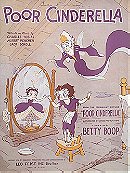
 21
21
 7.1
7.1
 0
0

